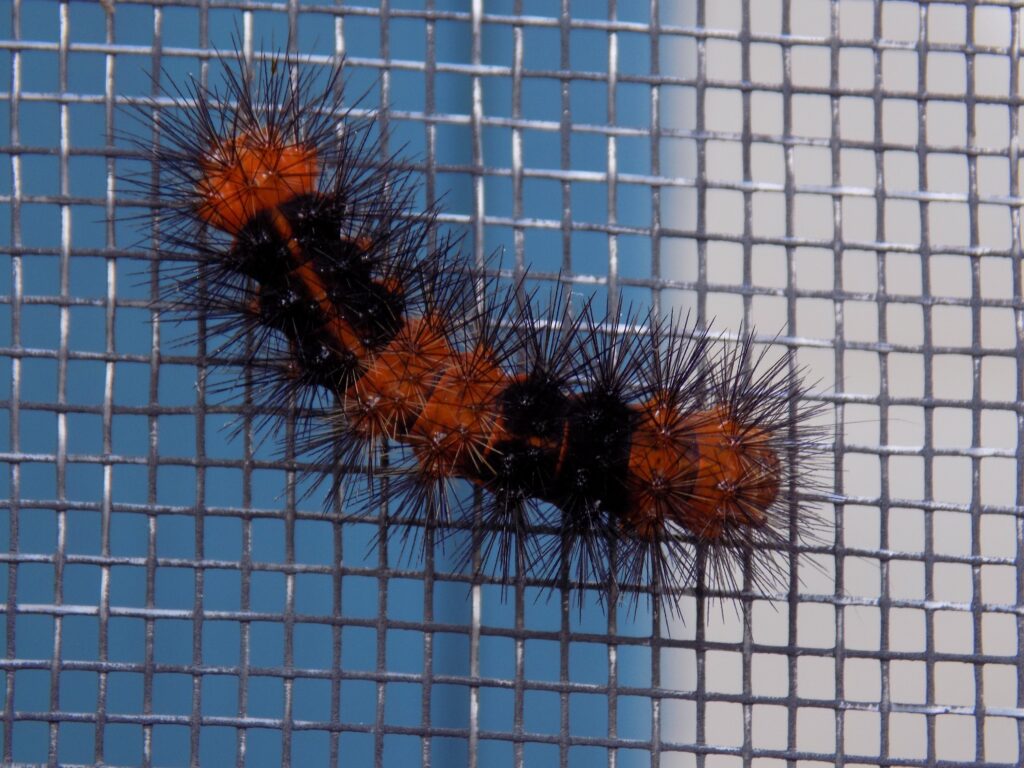
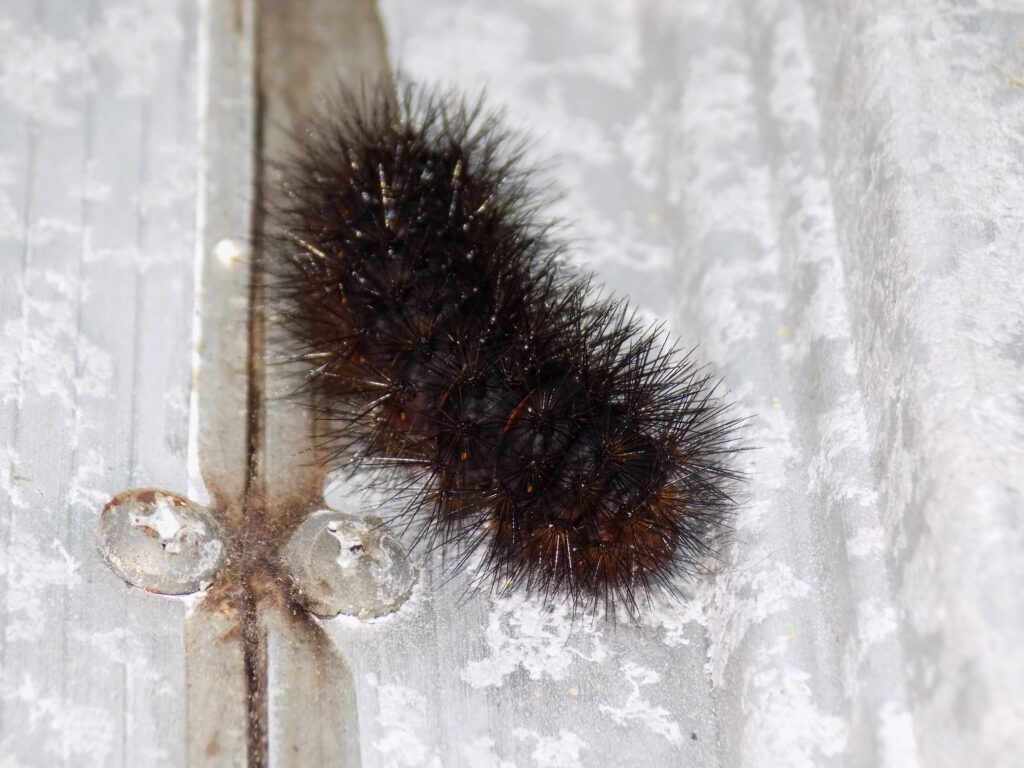
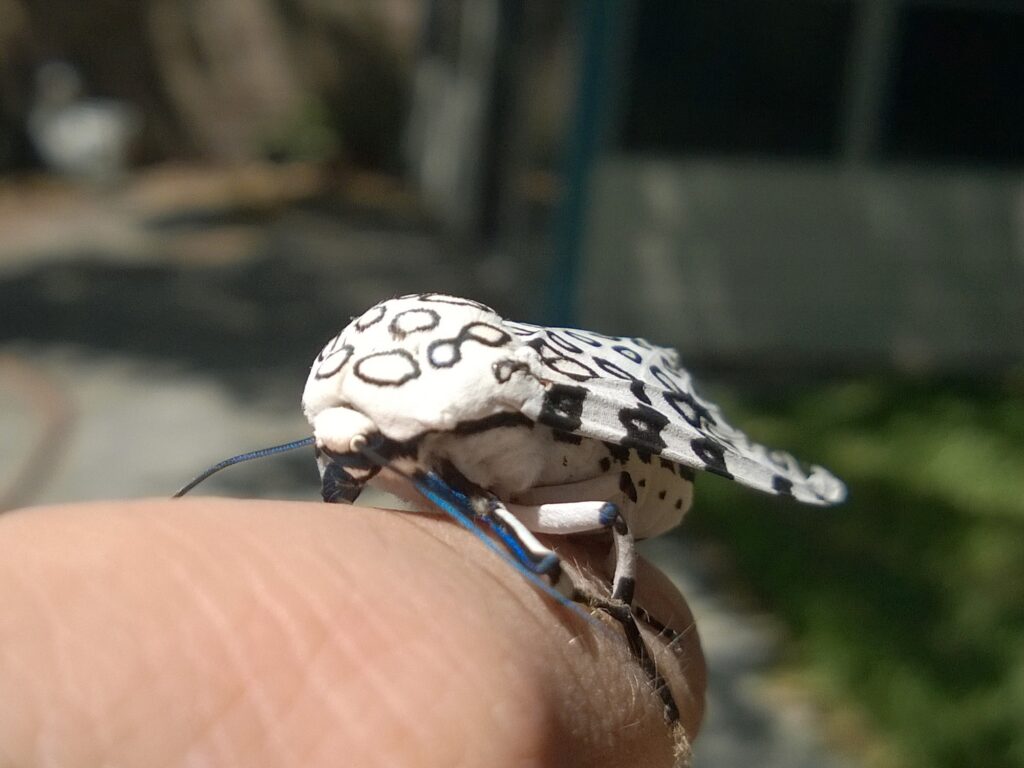
This week for Flora and Fauna Friday we have a two-stage, bi-colored insect that’s doubly easy to recognize, the Giant Leopard Moth (Hypercompe scribonia).
The Giant Leopard Moth is a fairly large moth in the Tiger Moth tribe, Arctiini. This moth is about two-inches long and mainly monochromatic in pattern. Their wings are pearl-white and spotted with rings and blotches of matte black. Yet, beneath those wings hides an abdomen of pastel-orange and iridescent-sapphire. A hard to miss and elegantly beautiful moth if ever there was one! What’s equally hard to miss is their caterpillar. The larval stage of the Giant Leopard Moth is what is colloquially known as a “wooly-bear” caterpillar. Their caterpillars get this name from being cloaked in a pincushion pelage of stiff hairs, giving them a thick and fuzzy appearance, like a bear’s winter coat. We have several species of Tiger Moth whose caterpillars go by the Woolly-bear nickname but the Giant Leopard Moth larvae’s are particularly recognizable. When fully grown, their larvae are a deep, semigloss-black with burgundy tones below and flashes of ruby-red in the joint between each body segment. In their younger instars, they have a banded two-tone appearance of black and cayenne-red. These caterpillars reach nearly three-inches in length in their final instar!
The Giant Leopard Moth’s caterpillar feeds on a wide variety of plants and the species is a common sight for gardeners throughout the Lowcountry. They’re often found scurrying around in backyards or cozied up in a silken hammock beneath yard debris, palmetto fronds, brick piles, forgotten pots, and wayward lumber. Unlike some of our other fuzzy caterpillars, these Woolly-bears are safe to handle and can’t sting. Their only defense is rolling into a difficult to swallow ball when bothered. Giant Leopard Moths overwinter as caterpillars, pupate in late spring, and the nocturnal adults emerge and fly throughout the summer.
This week for Flora and Fauna Friday, we’ve got a genus of wet-footed wetland shrubs, our Willows (Salix spp.).
Here in South Carolina we have four native species of Willow: Black Willow (S. nigra), Carolina Willow (S. caroliniana), Prairie Willow (S. humilis), and Silky Willow (S. sericea). Of those, Black Willow can be found statewide and Carolina Willow lives throughout the coastal plain. Prairie Willow is adapted to fire and found sporadically here in Longleaf Pine savanna ecosystems. Silky Willow is found in the Blue Ridge Mountains and its foothills. You’ll also see the ornamental Weeping Willow (S. babylonica), an exotic from China, planted around the State. For today, I’ll be focusing on Black Willow and Carolina Willow.
These two common Willow species share a variety of characteristics. Both grow on wet soils, all the way from damp to standing water. Both prefer full sun but can tolerate some shade. In growth form, they tend to be multi-stemmed shrubs, spreading outward into a spherical shape from ground to crown. These two species have leaves that are simple, finger sized and shaped, but with a long pointy tip. Both bloom in April to May with short spikes of goldish-green flowers. These mature into white tufts of windborne seeds which are blown far and wide with the aim to nestle along a damp pond bank. Willows also spread by their roots and through stem layering. They have pliable but fragile limbs, which break and propagate readily from cuttings, an adaptation for life on river banks where violent floods can rip a Willow apart and cast it downstream. Its weak wood allows the limbs to break away, protecting the roots and allowing the Willow to re-sprout. Simultaneously, the broken branches can root anew on a sandbar or logjam downstream.
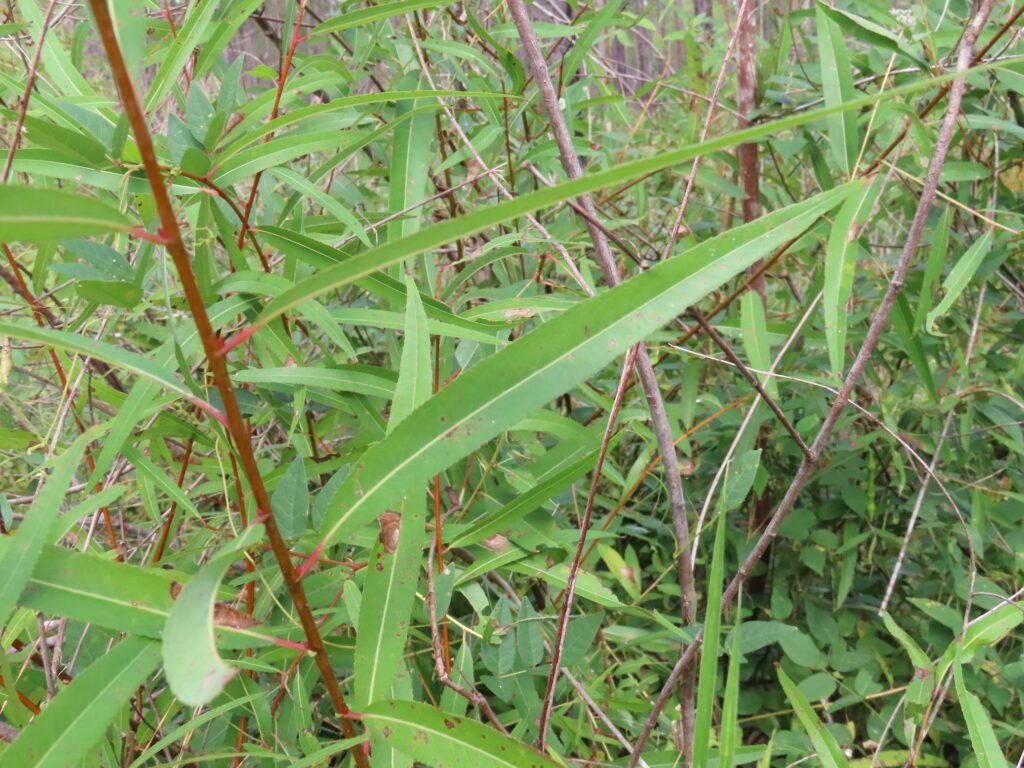

Black Willow is a highly adaptable species, growing in a plethora of soil types and into a myriad of shapes. Most commonly, it’s found growing along pond edges, stream banks, and in shallow, sunny wetlands. Normally it grows as a hedge of expanded shrubs but, in stable conditions, will grow up into a reasonably sized tree.
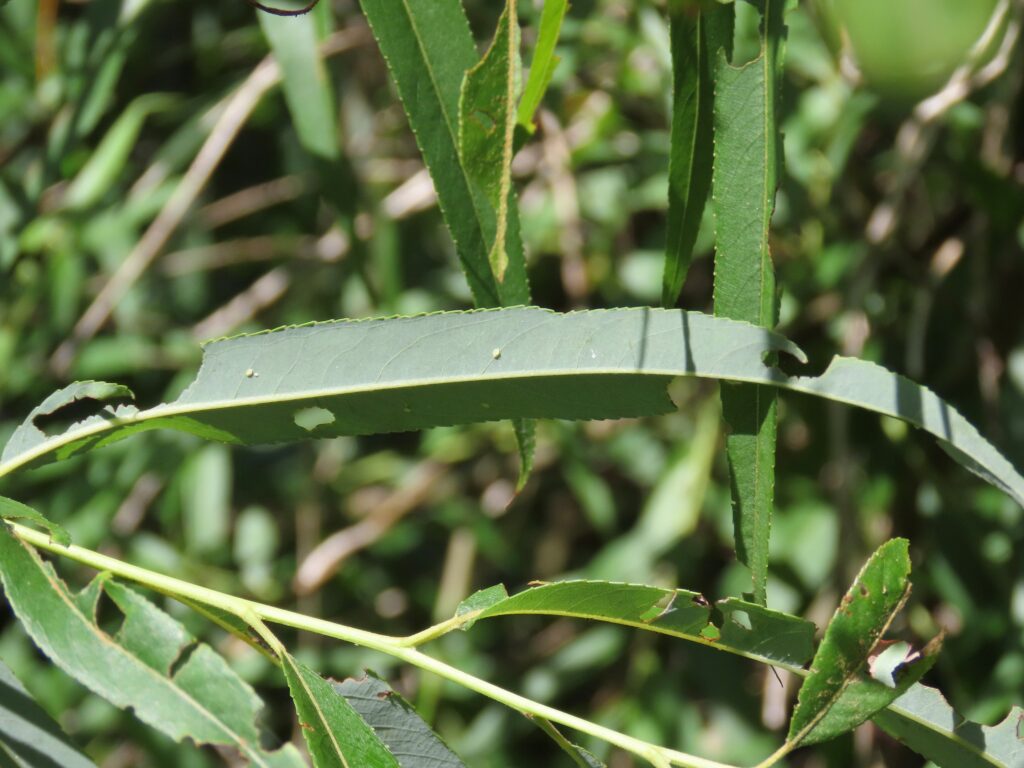
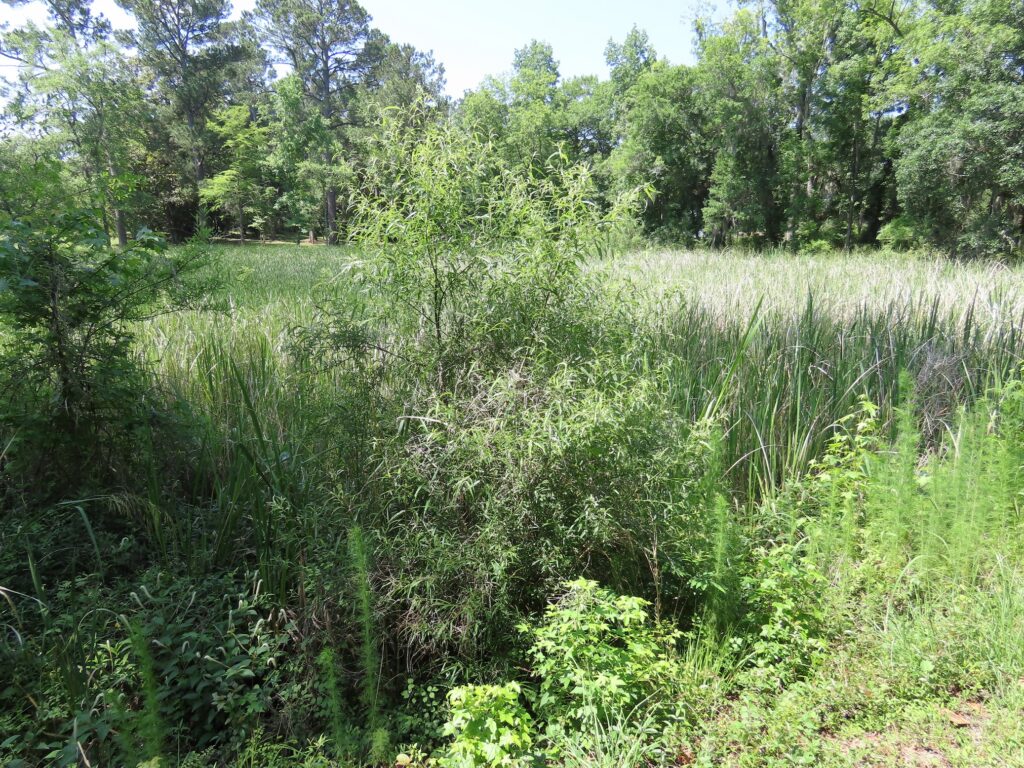
Carolina Willow is very similar in appearance to Black Willow but needs wetter soils to thrive. It also doesn’t really grow into a tree, staying as a large hedge or shrub. It’s found in similar wetland margin habitats but has more salt tolerance, and so is often found closer to the coast and in old tidal impoundments. The quickest way to tell these two species apart is by their leaves. Black Willow leaves look about the same on the top and bottom. Conversely, Carolina Willows have silvery-white undersides to their leaves.

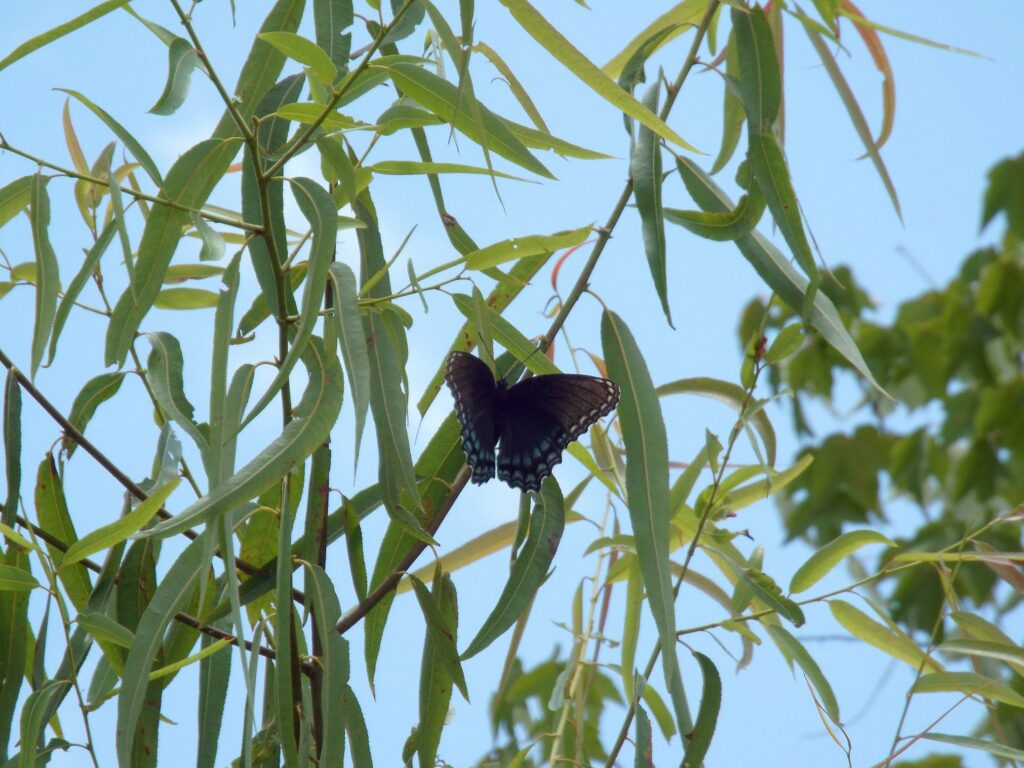
Willows have a lot of wildlife associations and provide ecosystem services. Their flowers are dual-pollinated, spreading pollen on the wind but also working with pollinators, specifically bees, trading pollen for transport. Willows are also the caterpillar host plant for three of our large, showy butterflies: the Eastern Tiger Swallowtail, the Viceroy, and the Red-Spotted Purple. The ecosystem services Willows provide make them a valuable asset in wetland systems. As a supple, spreading shrub that grows on wetland margins, Willows provide three key benefits to wetland ecosystems. They stabilize banks with their roots, they slow water and trap sediment in their labyrinth of stems, and they provide both shade to fish and structure to aquatic animals living beneath them. One final fun fact, the living tissue of Willows contains Salicylic Acid, which is used widely in indigenous medicines as a pain reliever and was isolated in the early 1800s to create the drug Aspirin.


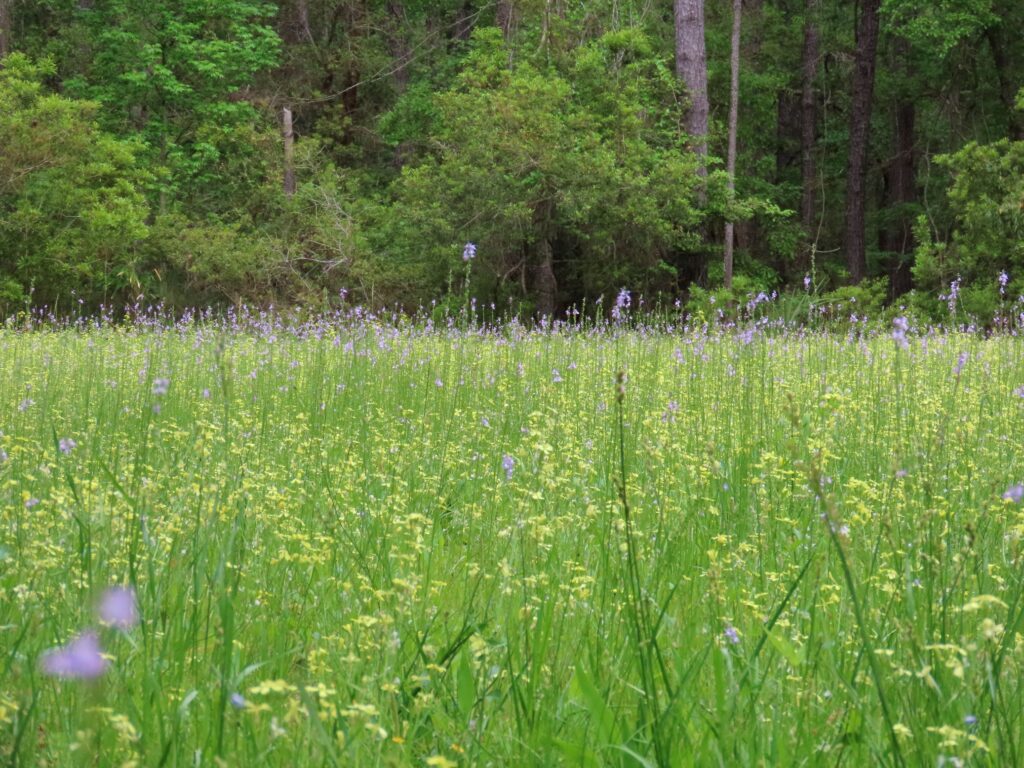
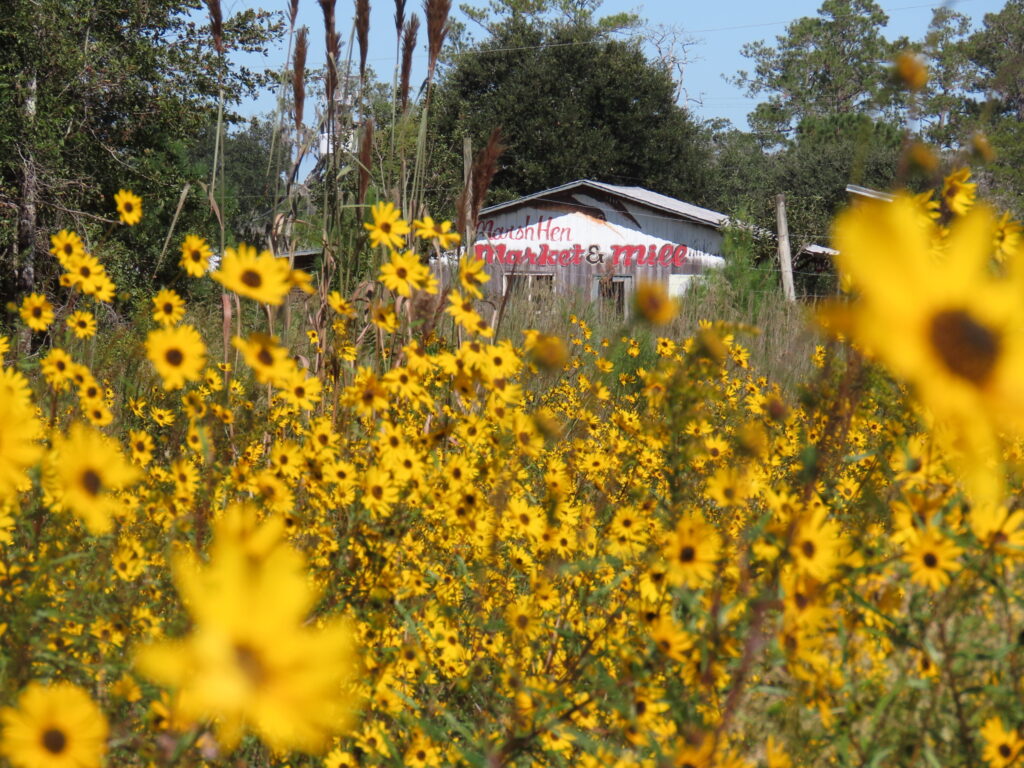
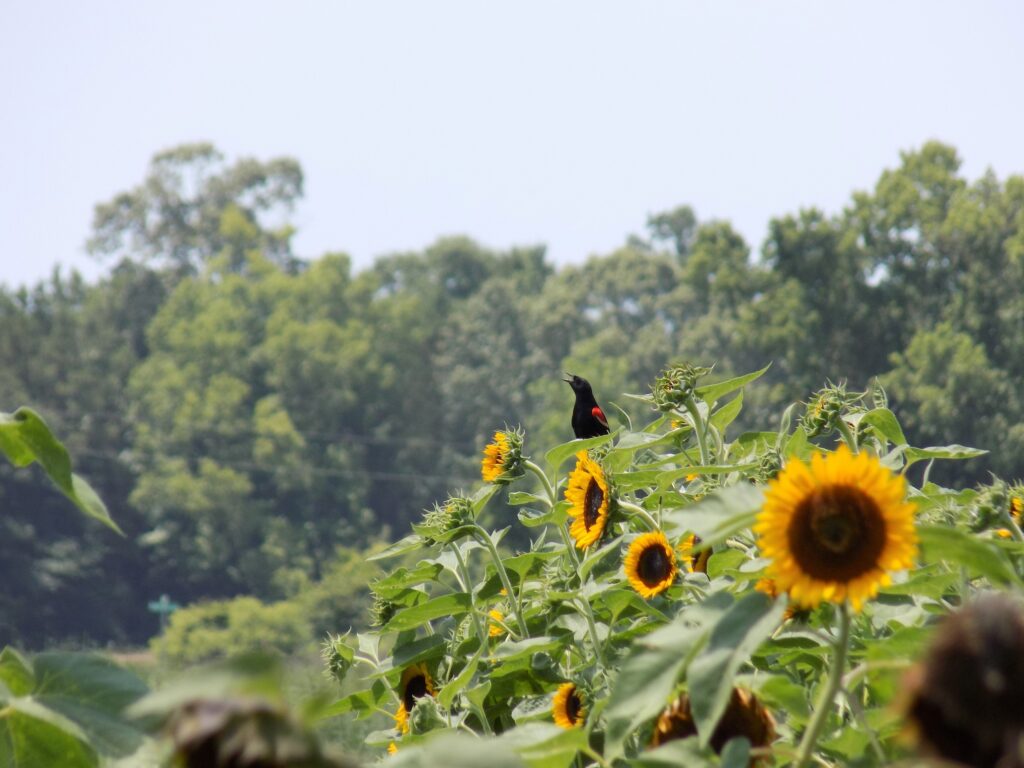
This year for Pollinator Week (6/17 – 6/23) we’re doing a 7-part series about native pollinators on Edisto Island!
We, as a civilization, need pollinators. They keep the gears of agricultural and ecosystem services turning behind the scenes, rendering an invaluable service to plants, which yield these values to us. Pollinators need our help. Thankfully, pollinators are everywhere and anyone can lend them a helping wherever they are.
Pollinators are a diverse group of animals adapted to a wide range on ecosystems, habitats, and environmental conditions. They’re able to fend for themselves and don’t need any special treatment as a whole. However, they are all being hit from every angle with overwhelming forces they can’t overcome on their own. The biggest threats to pollinators right now are misuse of insecticides and habitat loss. As an individual, these threats are easy to dissipate at the small scale. Don’t fog for mosquitos, don’t spray insecticides in your garden, leave leaf litter around the edge of your yard, create a brush pile, leave dead flower stems alone, don’t mow as often, and plant native plants where ever you can.
However, the biggest contributor to both these threats in the Lowcountry is suburban sprawl. The best way to curb sprawl is by supporting local land conservation efforts. Land conservation is what we do here at EIOLT. We protect dirt from destruction. We save special places for tomorrow. We humans rely on natural ecosystems and agricultural crops for food and natural resources. Food crops and natural ecosystems need pollinators. Pollinators need native plants. Native plants need soil. Soil is the land. In order to protect our native pollinators and safeguard our futures, we need to first protect the land that we all rely on. Protect places for plants, for pollinators, for people, for the future, forever. The work of the Edisto Island Open Land Trust protects the capacity of land to support pollinator habitat, our native plants, our wildlife, our natural resource economy, and the intrinsic beauty of Edisto Island. We need your help to conserve land, and everything that relies upon it. If you’re not a member already, please considering joining EIOLT and, if you are, thank you, sincerely, for all that do to protect the one-of-a-kind Edisto Island.
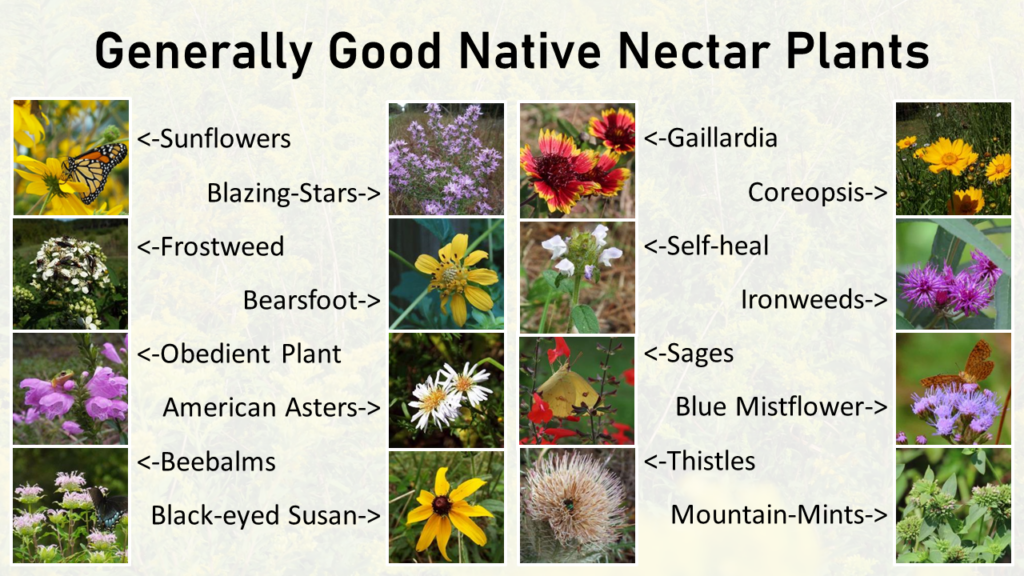
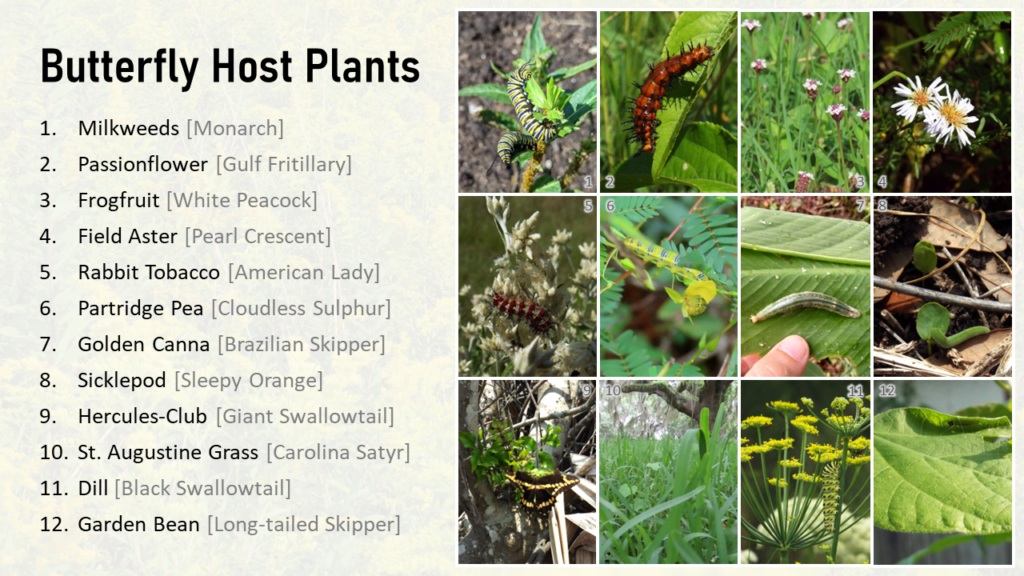
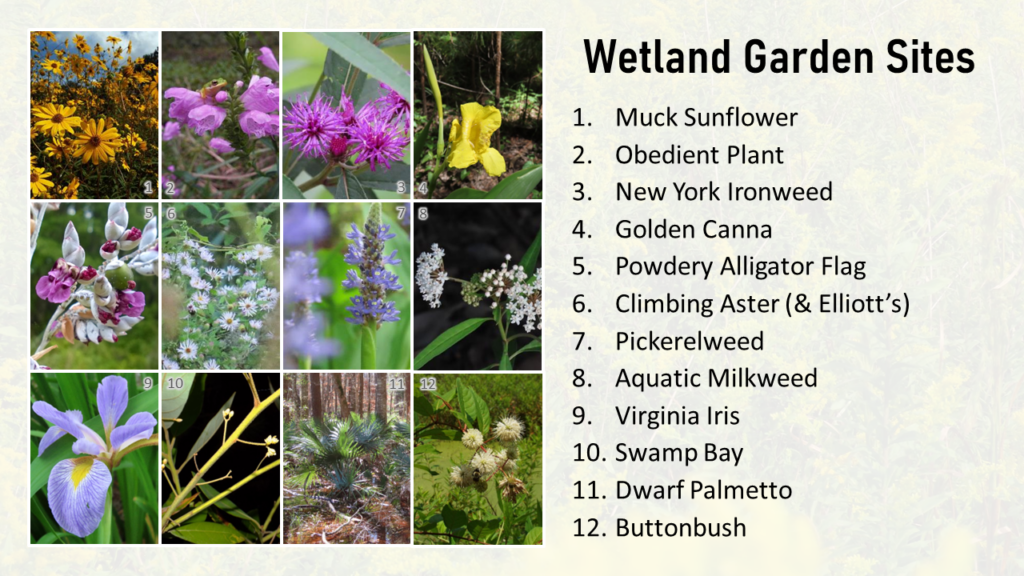
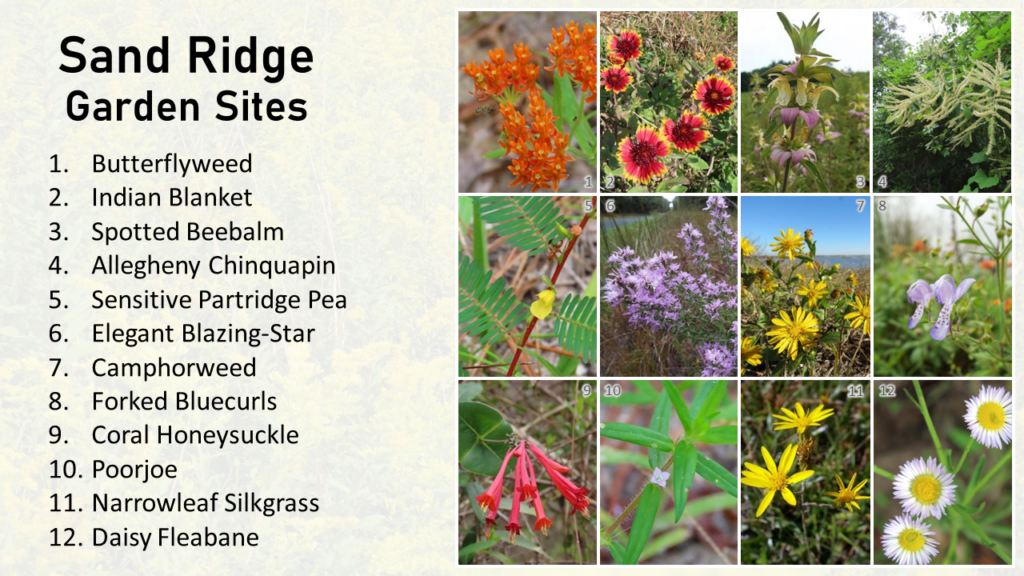
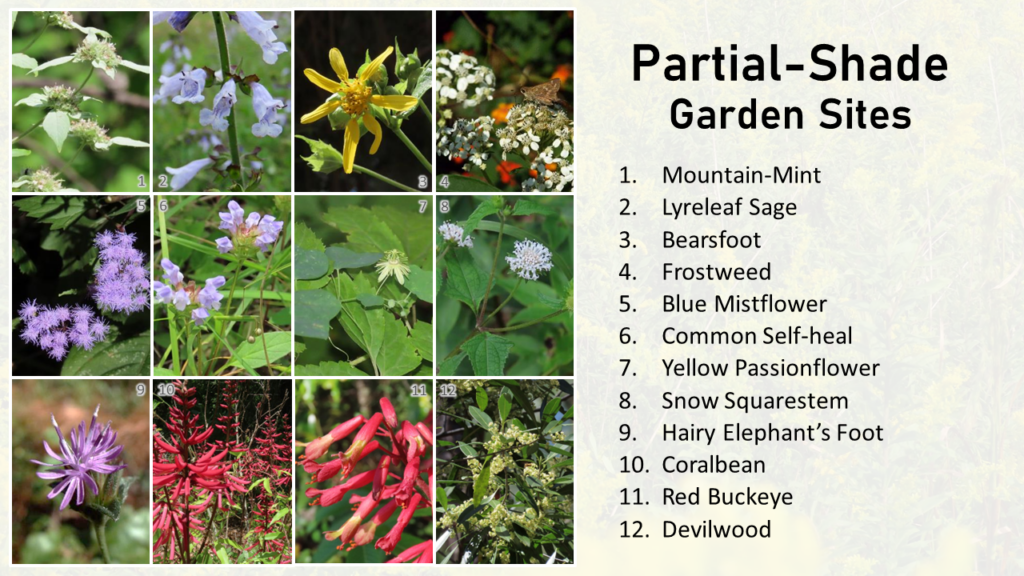
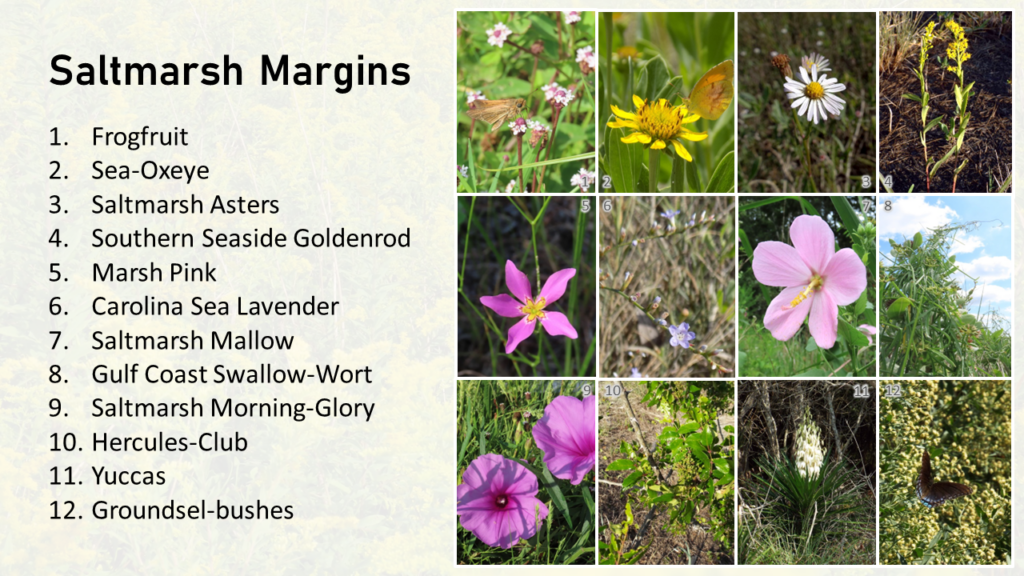
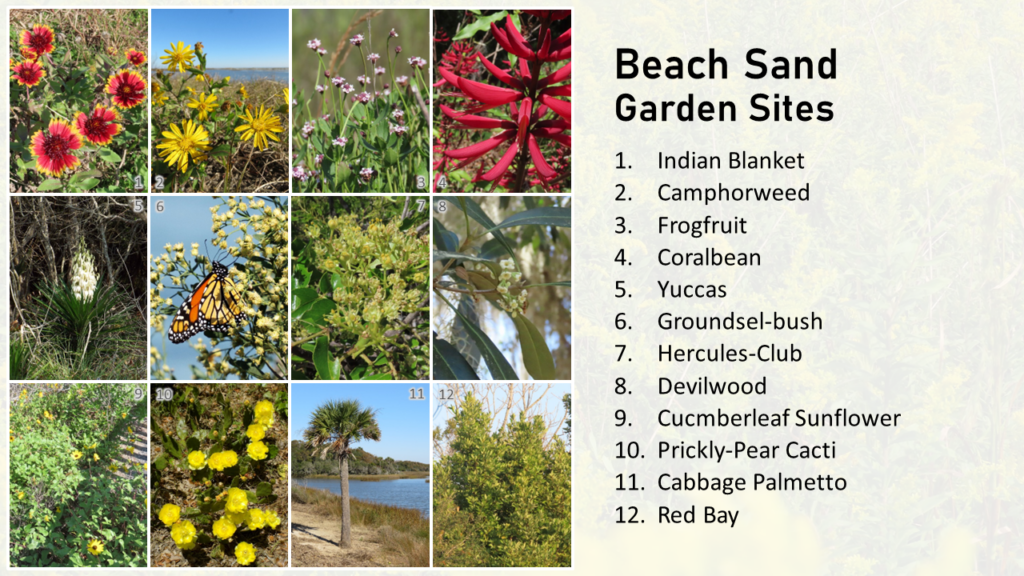
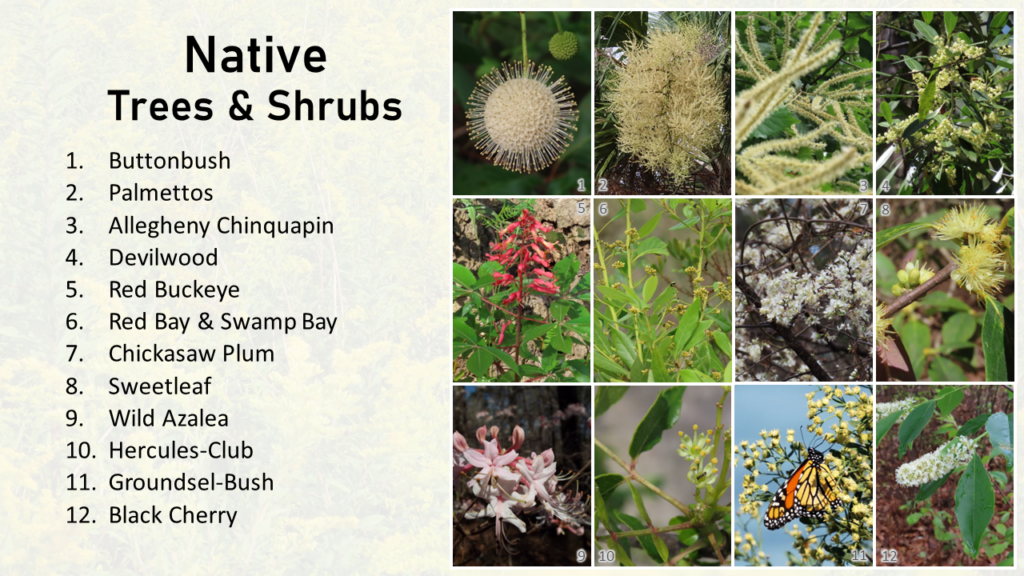
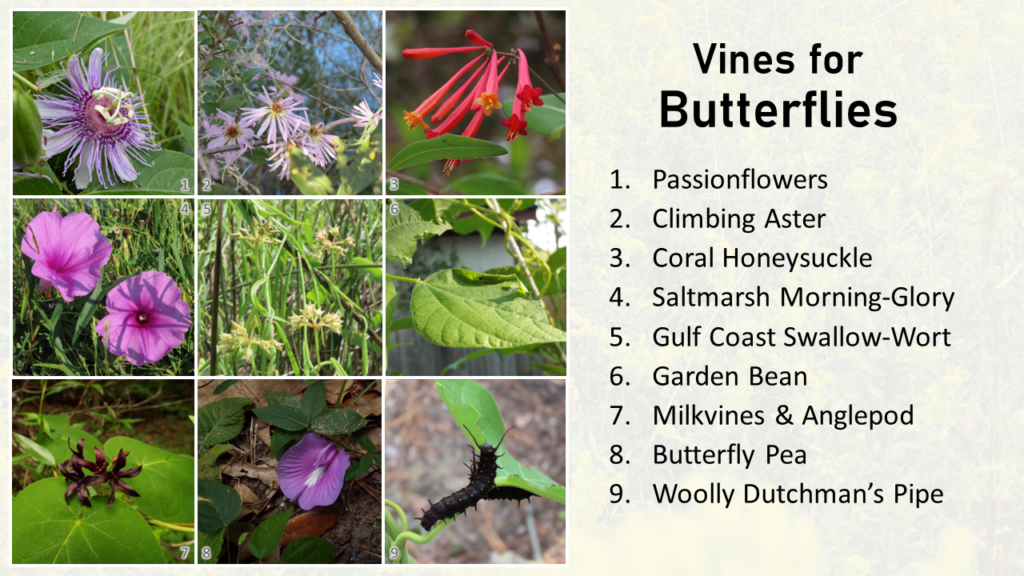
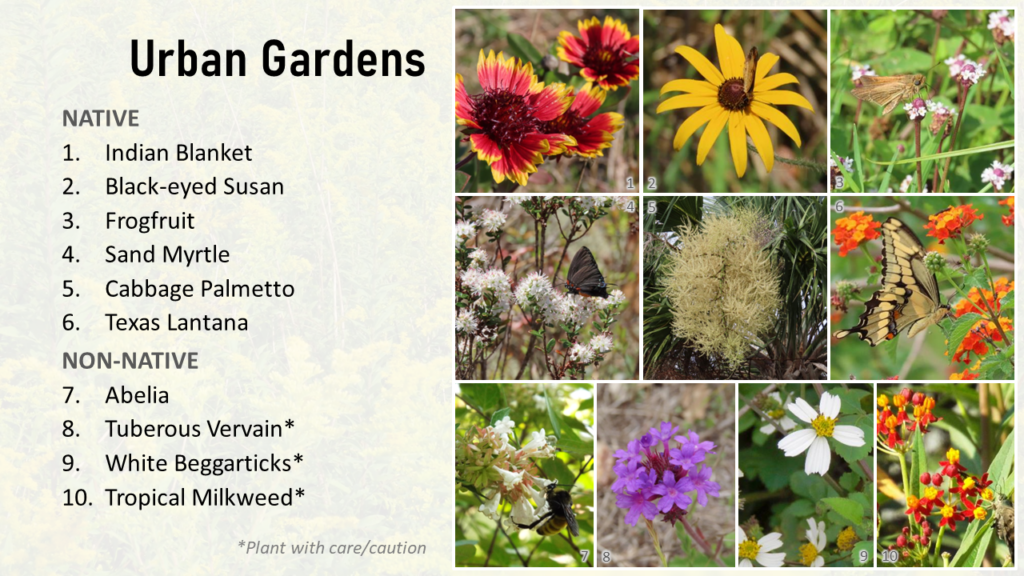
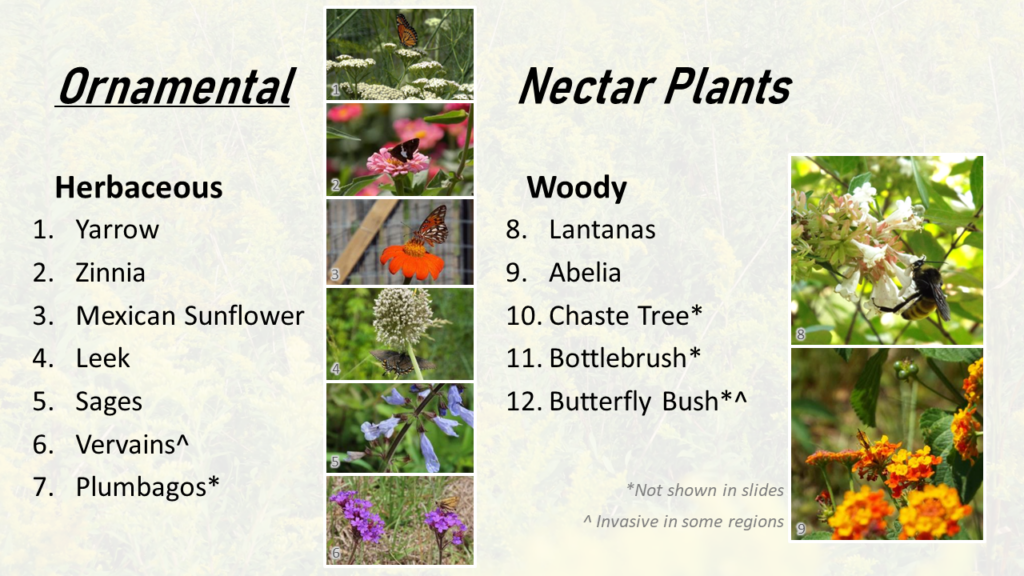
Pollinator Week 2024: Pollinator Plant Recommendations for Edisto Island
This year for Pollinator Week (6/17 – 6/23) we’re doing a 7-part series about native pollinators on Edisto Island!
If you’re considering building a pollinator garden, bringing native plants into your yard, or managing land for pollinator habitat, you’re going to need to know which plants work best for Edisto Island. Here, we’re in the borderline subtropics of the Lowcountry, meaning many plant recommendations you’ll find online for the Southeast US often aren’t worth much of anything. However, lucky for you, I’ve spent the better part of the last decade planning, planting, and managing native plant gardens in the Edisto area. So, I’ve got a good handle on what works and what doesn’t here and I know the plants that are specialized to our unique sea island soils and climate. I also spent all of this spring building out a set of slides and a pollinator garden plant recommendation list focused on Edisto Island.
If you’d like to give them a gander, check out the link below:
These plant recommendations of mine are specifically focused on butterflies (because, as a butterfly researcher, I’m biased) but almost all are good for a wide range of our native pollinators. One thing I do want to stress is the importance of using native plants in your pollinator garden, yard, and lawn. Native pollinators are adapted to make use of native plants. Native plants are adapted to our local climate, soils, and wildlife. Native plants, pound for pound, will always be better for our native pollinators and wildlife than any exotic ornamental plant. Further, many ornamental plants, even the ornamental varieties of native plants, have been bred in such a way that they no longer provide all the benefits they should to pollinators. So, plant native and, if you can, plant local ecotypes of native plants. These plants will grow better, require less care, and provide the maximum benefit to our native pollinators and wildlife.
For further information, recommendations, and sources of native plants and seeds, you can also check out the SC Native Plant Society and Xerces Society, both linked below:
https://xerces.org/pollinator-conservation/native-plant-nursery-and-seed-directory
This year for Pollinator Week (6/17 – 6/23) we’re doing a 7-part series about native pollinators on Edisto Island!
If you want to go the extra mile to help our native pollinators, then you should consider planting a pollinator garden or, if you have a bit of acreage, managing a pollinator habitat. A pollinator garden has the expressed intent of maximizing its benefit to native pollinators. A pollinator garden should have the goal of becoming an island unto itself, a microcosm providing everything our pollinators need to flourish and persist or, at the least, a lot of what they need but aren’t getting from the surrounding landscape. To create a full-fledged and functional pollinator garden you need to provide 4 main features.
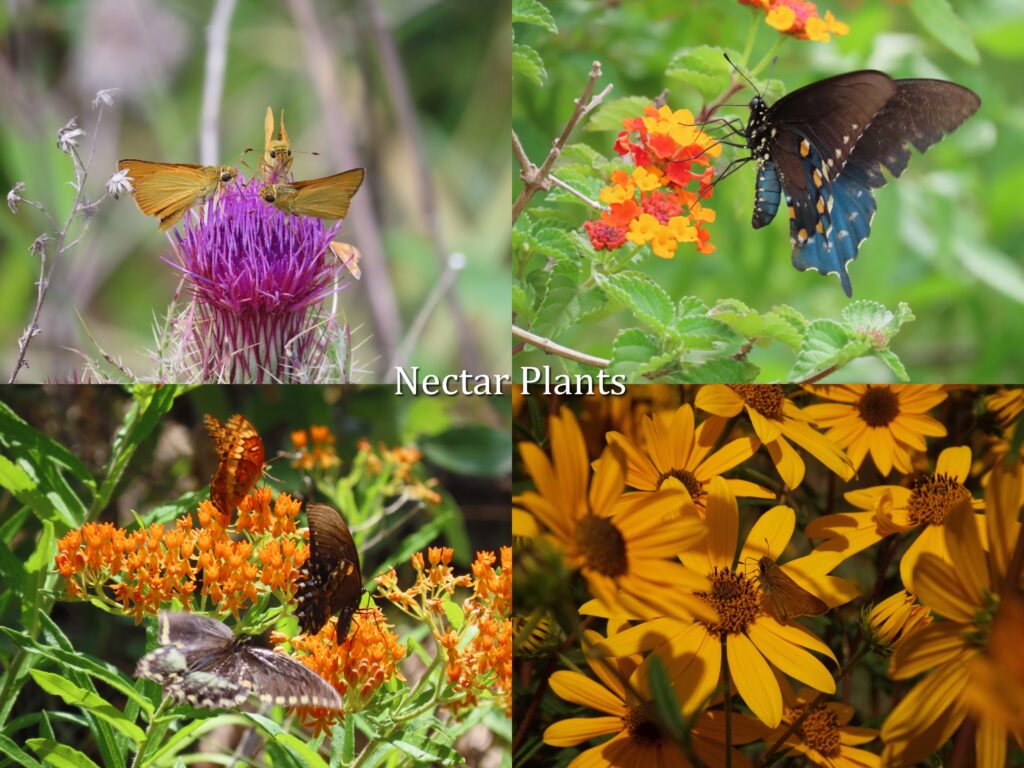
First, nectar plants. Nectar plants provide food for adult pollinators. You need nectar plants of all shapes, sizes, colors, and bloom times to attract the greatest diversity of pollinators. The broader your nectar plant selection, the more reliable a food source your garden will be for pollinators.

Second, pollen plants. These feed baby bees. Bees are the most efficient pollinators and are doing the heavy lifting elsewhere, outside of your garden. You want to make sure you’re also providing bees with ample pollen, in addition to nectar, to feed the next generation of bees all throughout the year. Our native bees come in all shapes and sizes, so a diversity of flower sizes and shapes is a must.

Third, host plants. Host plants are the nurseries for your butterflies, and moths, since their caterpillars eat plant vegetation. Many butterfly species can only eat a specific set of plants. If you want to maintain a diversity of butterflies in your garden, you need to supply the adults with nectar and the caterpillars with leaves. Subsequently, these caterpillars become food for pollinating wasps, who feed them to their own little ones.

Fourth, refuge and nesting habitat. Pollinators need places to hide, to rest, and to nest. Leaf litter, old flower stalks, bare soil, brush piles, and old logs all provide refuge habitat to certain types of pollinators during different stages of the life cycle. So, leaving a pollinator garden messy and debris untouched is often both the best thing for pollinators, and it’s as easy as doing nothing at all!

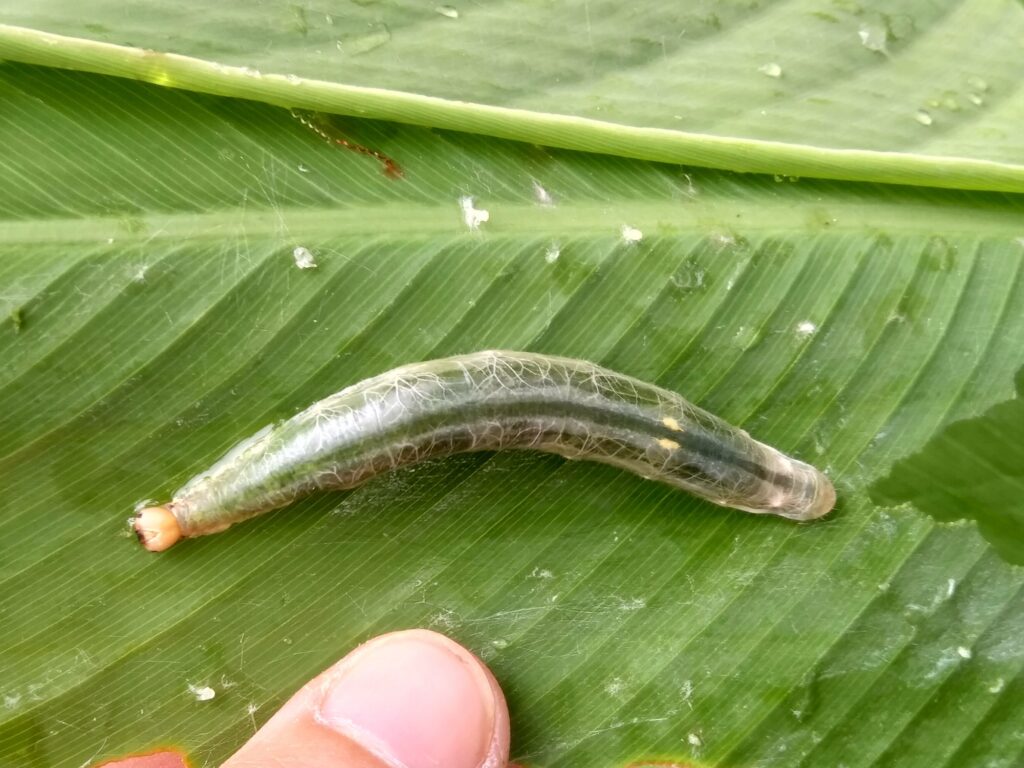


This week for Flora and Fauna Friday, we have a tropical butterfly with a transparent caterpillar, the Brazilian Skipper (Calpodes ethlius).
The Brazilian Skipper is large for a skipper, at about an inch-and-a-half in length with an elongated forewing. The underside of their wings is a golden-brown with four white cells, the technical term for spots, in a diagonal line towards the outer edge of their hindwing. From above, their wings are a dark brown towards the center with a half-dozen or so large, blocky white cells. Their eye is surrounded with a prominent white eye-ring. Overall a drab butterfly that’s a bit overgrown and with some anatomical quirks. Being a large skipper, Brazilian Skippers are strong and fast fliers, zipping around between flowers and perches. Their large size and an extra-long proboscis allows this butterfly to easily sip nectar from larger flowers, those usually reserved for acrobatic hummingbirds and spelunking bumblebees. Brazilian Skippers are mainly crepuscular, flying at dawn and dusk, and so are scarcely seen during the day. They’re most easily found in close proximity to their host plants or as caterpillars.
Brazilian Skipper caterpillars host on two genera of plants, Canna and Thalia. Here in the Lowcountry, we have two native host plants for the Brazilian Skipper, Golden Canna (Canna flaccida) and Powdery Alligator-Flag (Thalia dealbata). Both are rare with few natural populations in South Carolina. However, they are also both popular and hardy aquatic plants commonly sold by plant nurseries, alongside the even more popular and widespread Canna Lily (Canna indica) from South America. All three species are natural host plants for the Brazilian Skipper, which is adept at eating them! The Brazilian Skipper actually goes by another name in the nursery trade. Its infamous alter ego is the “Larger Canna Leafroller” and they can do some damage, albeit superficial damage, to their ornamental host plants, which has evoked the ire of horticulturalists. Brazilian Skipper caterpillars feed using the leaf-rolling technique. Young caterpillars will cut two slits in the edge of a leaf, then fold it over on top of themselves self like a little caterpillar taco, attaching the folded leaf in place with silk. There the caterpillar is safe from the elements and will poke its head out to chew on the edge of its roof. When it eats itself out of house and home, it will move to a new spot on the leaf to tuck itself into a bigger bed and breakfast. These caterpillars are also very unique in appearance. They have a khaki colored head, transparent skin, and green innards spider-webbed with white tracheal tubes, this insect equivalent of lungs being visible through their see-through skin. Eventually this caterpillar will grow to a chunky three inches in length. At that point, it will move to a new leaf and fold it in half. In this final cozy abode it will pupate into a powdery, pale green chrysalis and eventually emerge a fully formed butterfly.
This year for Pollinator Week (6/17 – 6/23) we’re doing a 7-part series about native pollinators on Edisto Island!
Today let’s dive into one special group of pollinators, the Butterflies. Butterflies are a subset of the moths, the superfamily Papilionoidea. Butterflies all share 2 common features: they fly during the day and have “clubbed” antennae. In the Lowcountry, we have about 130 species of butterfly, which come in a wide array of sizes, colors, shapes, behaviors, and life histories.
Butterflies, to be frank, are mediocre pollinators. They have a long, prehensile proboscis to sip nectar out of flowers at a distance. This means they don’t walk around on flowers much and don’t pick up a lot of pollen. Some plants are specialized for butterfly pollination but, generally, butterflies aren’t moving all that much pollen around. Yet, butterflies have 3 special characteristics that make them valuable to pollinator habitat conservation.

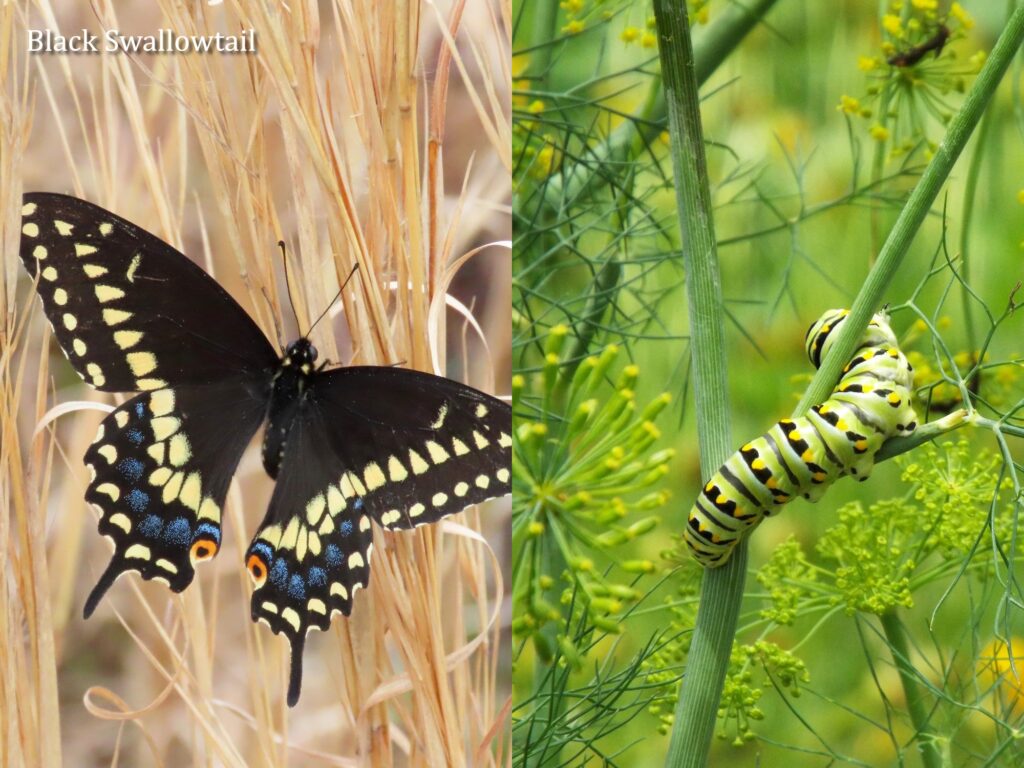
First, butterfly caterpillars feed on plant leaves. This makes butterflies a plant “pest” in some ways but, in reality, they and moths serve as a natural check-and-balance for native plants. If one plant has a banner year, moth and butterfly populations spike, eating more of that plant and keeping it in check, so it doesn’t dominate a habitat. In turn, wasps eat these caterpillars so they themselves don’t get out of hand.
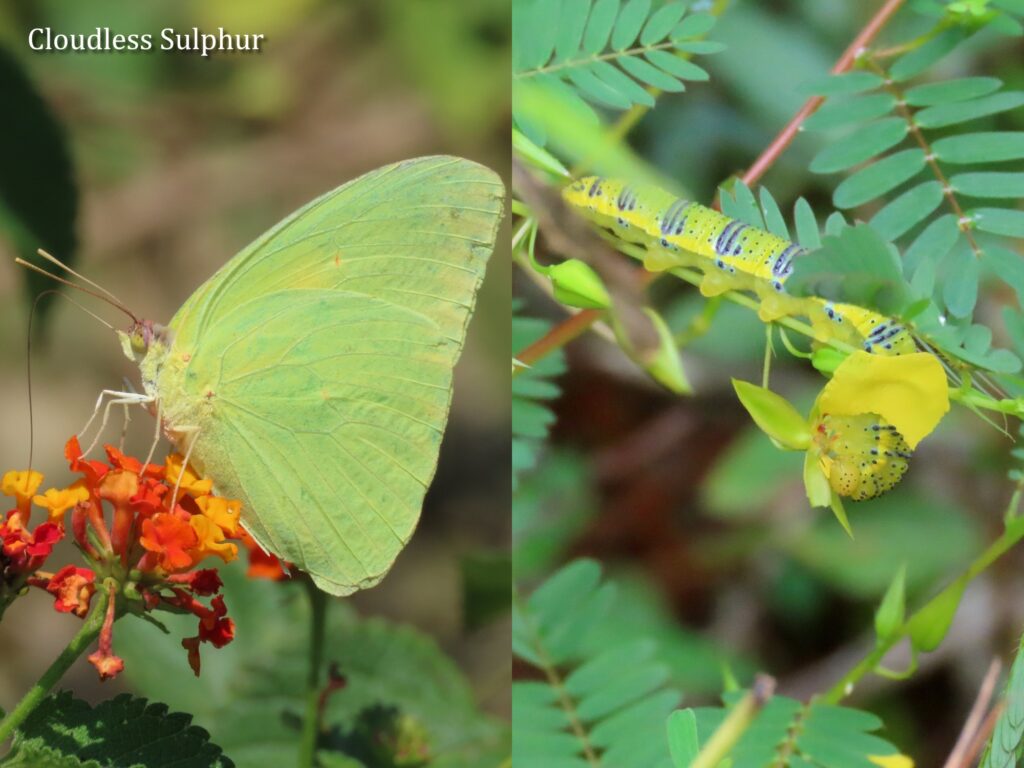
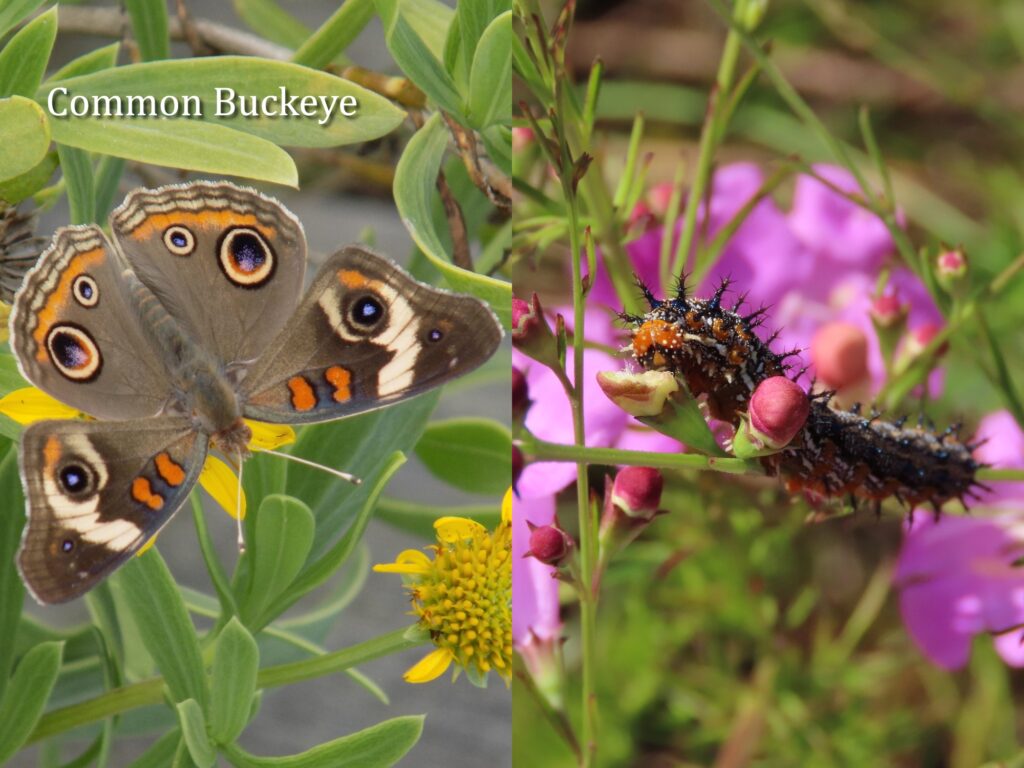
Second, butterflies are a great indicator species for the health of a pollinator habitat or ecosystem. Butterflies are also easy to spot and identify, which is important for indicator species. Butterflies respond quickly to environmental changes, weather, and climatic trends. So, their populations follow conditions that ecologists want to keep track of. Being plant eaters, they are also sensitive to insecticide and herbicide use, declining faster than other species and indicating a problem sooner.
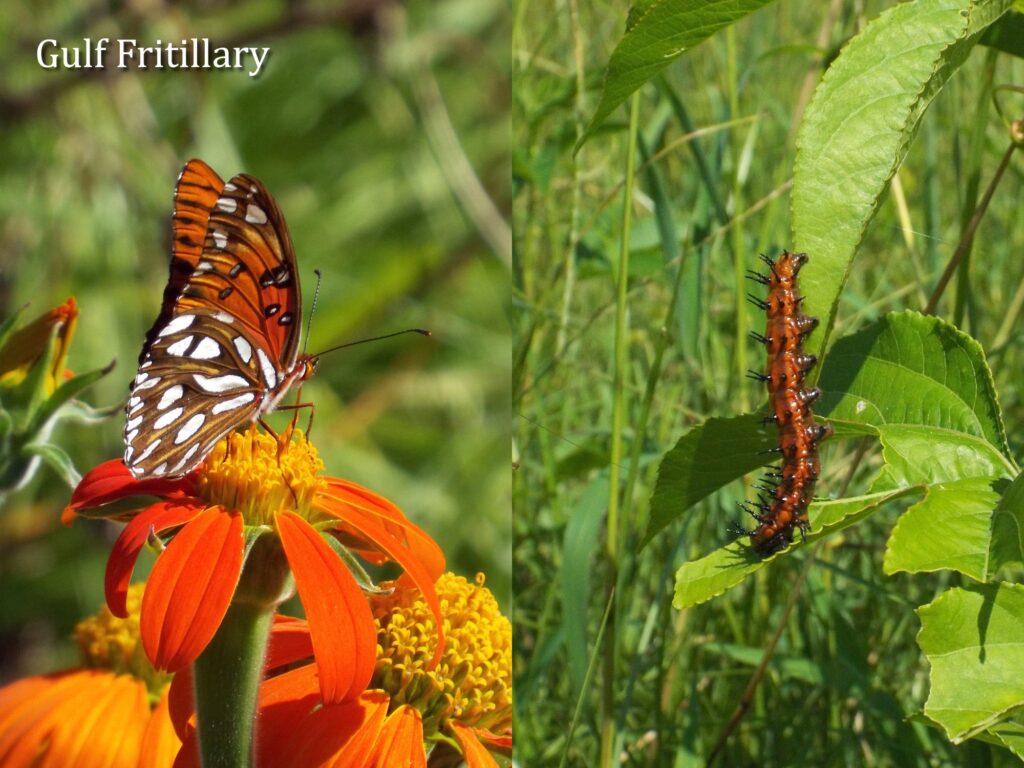

Third, butterflies are the quintessential pollinator ambassador for folks. They’re big, they’re pretty, they’re easy to watch, they’re harmless, and can be raised from egg to adult in a classroom terrarium. Their herbivorous caterpillars demonstrate the inextricable link between insects and plants and their adults like the same big pretty flowers we humans love to plant. They’re the poster children of pollinator conservation.
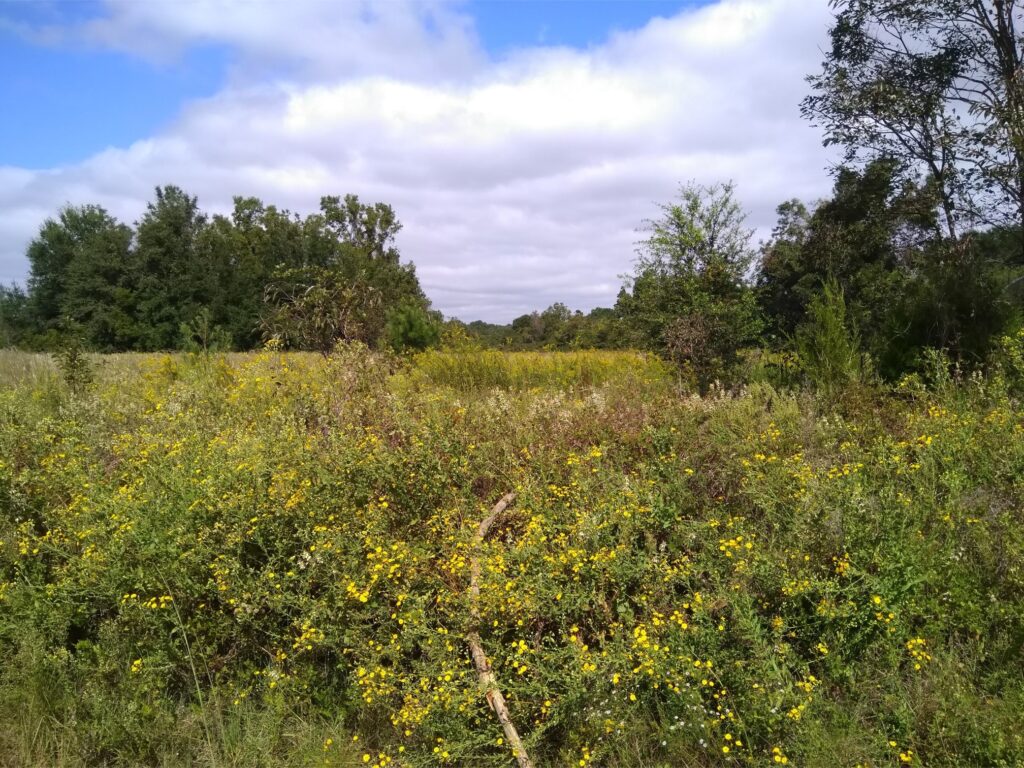
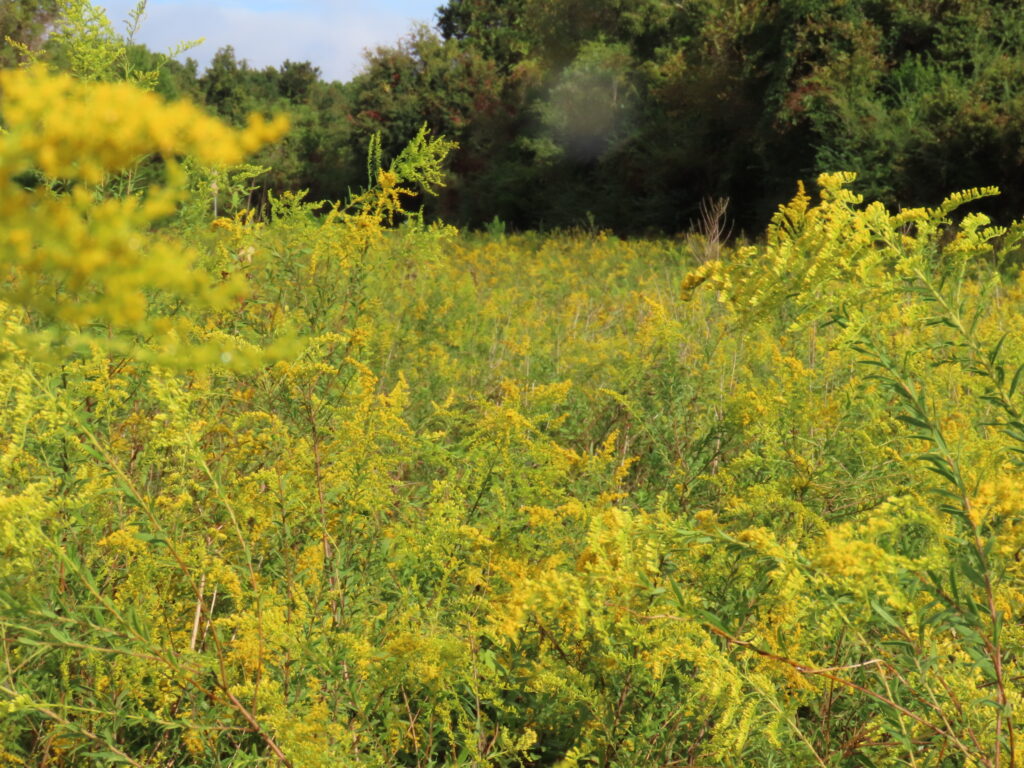
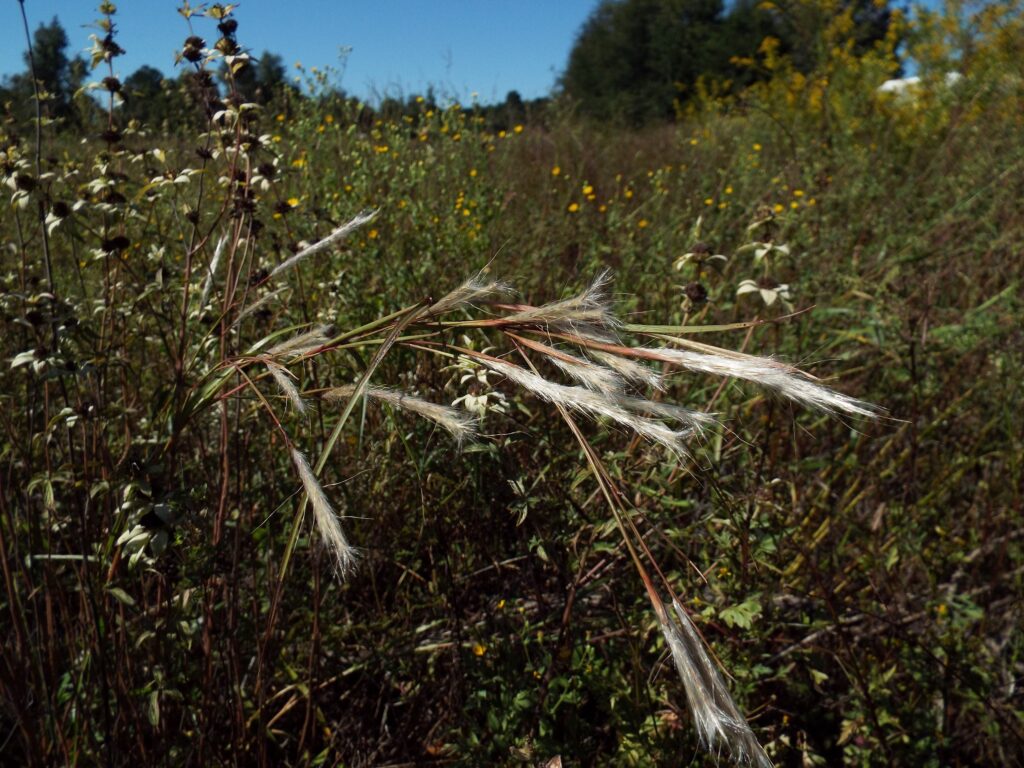
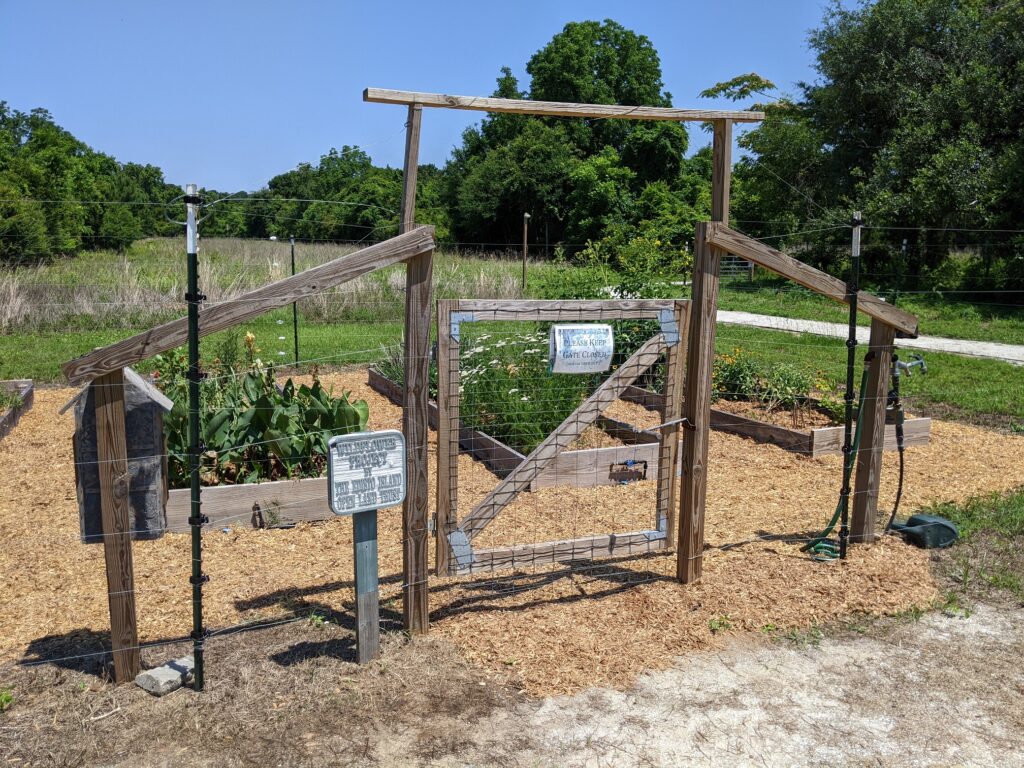
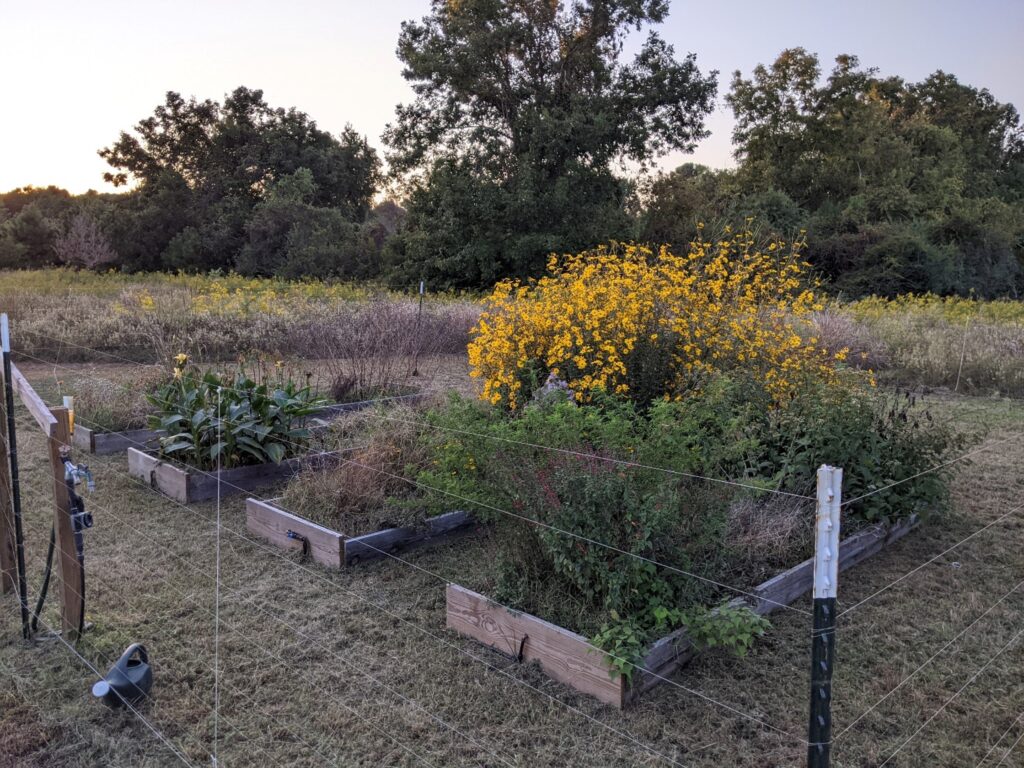
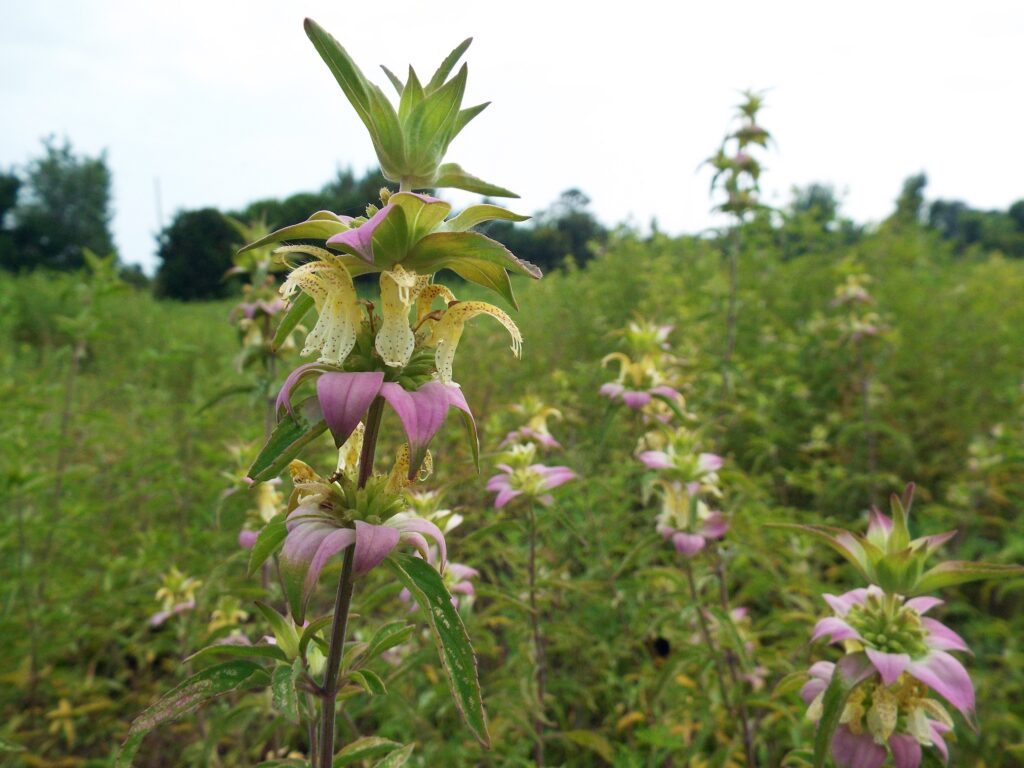
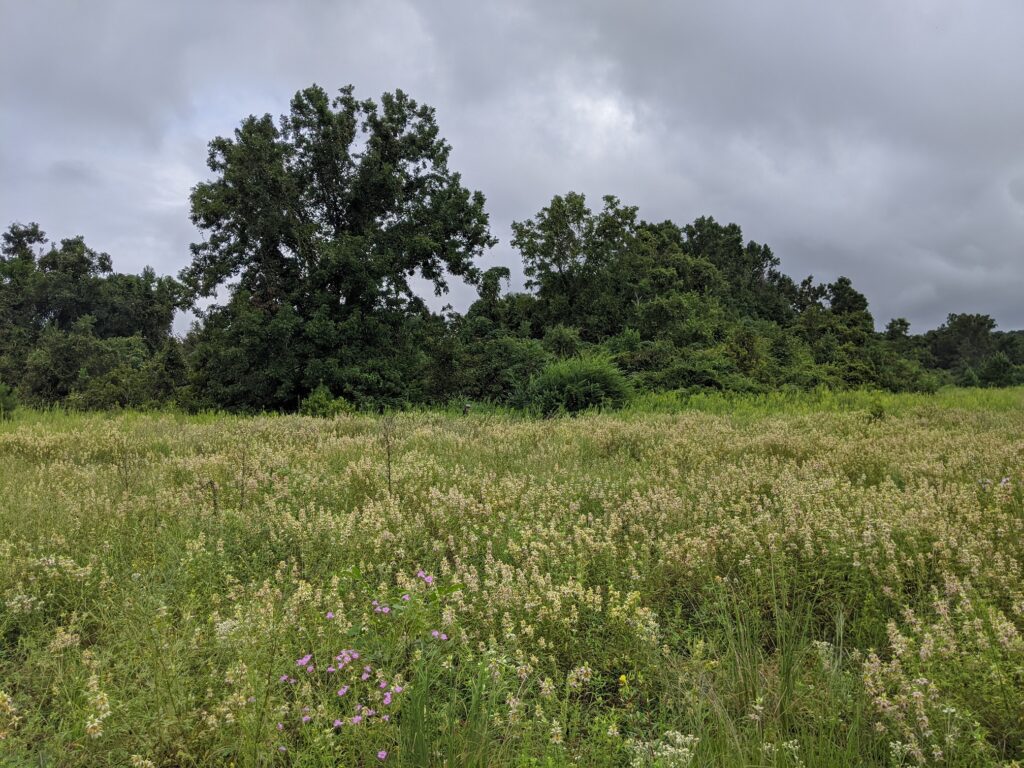
This year for Pollinator Week (6/17 – 6/23) we’re doing a 7-part series about native pollinators on Edisto Island!
The Hutchinson House is an iconic local landmark and touchstone for interpreting African-American history on Edisto Island from the Emancipation through Reconstruction and onward. EIOLT has worked the last 8 years to restore the house and interpret its history.
Just as the House is significant to interpreting our history, the land it sits on is a stellar example for interpreting sea island Pollinator Habitat. EIOLT purchased the adjacent 9-acre lot in 2019 and have diligently maintained its existing wildflower meadows. These fields burst to life in fall with a profusion of native wildflowers that are inundated in a billowing haze of pollinators! We’ve even built a pollinator garden on site to better showcase the beauty of these meadows.
These wildflower meadows are what are commonly referred to as an “Oldfield” habitat. As the name implies, oldfields are agricultural fields left to go fallow. Often, they’re burned or mowed sporadically to control woody plants but otherwise are left to their own devices. An oldfield’s beauty is in its simplicity and purity. A field gone fallow allows for the local “seed bank”, the native plant seeds persisting in the top soil, to be exercised and showcased. Over time, new plant species will germinate from the bank and duke it out in the oldfield free-for-all until an equilibrium is reached. Throughout that process, plant structures, micro-habitats, complex ecological interactions, and diversity will build, creating stellar pollinator habitat.
“Pollinators” are not a monolithic group, it’s a loose collection of animals that spread pollen. Some need pollen, others nectar, some leaves, others leaf litter, hollow stems, bare soil, wet mud, or dead trees; every species has its own unique list of living conditions. Pollinators are a diverse group and, consequently, a diversity of habitat is needed to support them all. Diverse site conditions breed a diverse assemblage of plants, which in turn create a diversity of habitat, a sprawling miniature metropolis of stems and leaves, to support a diversity of pollinators.
Check out this video about the wildflower meadows at the Hutchinson House:

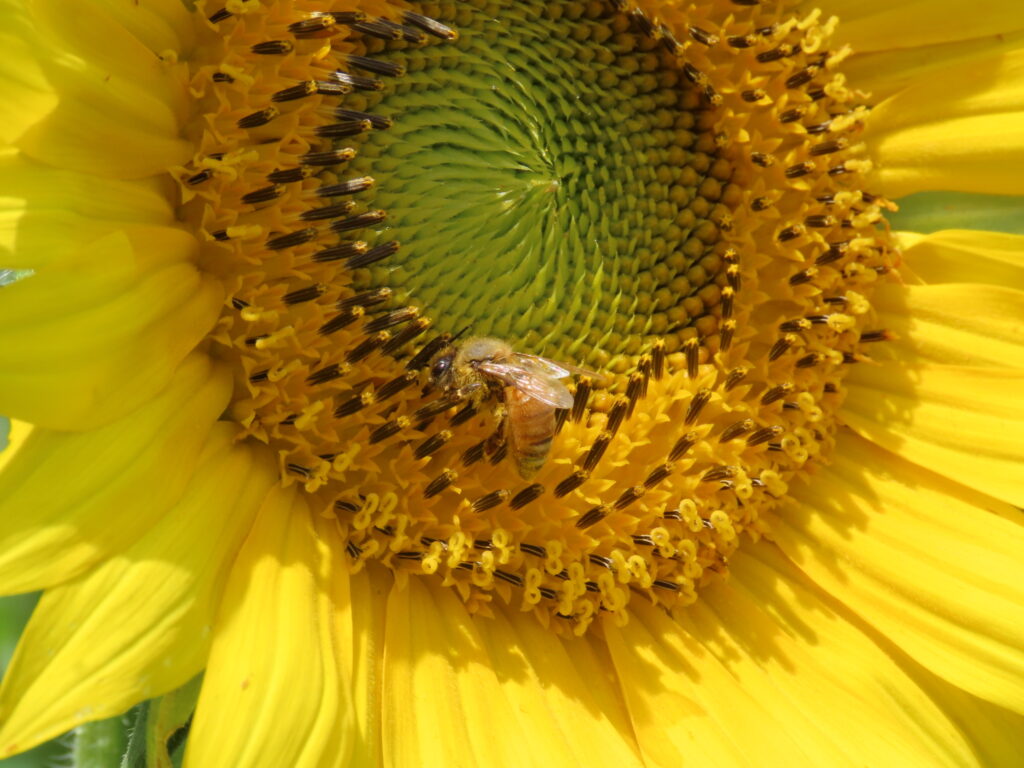
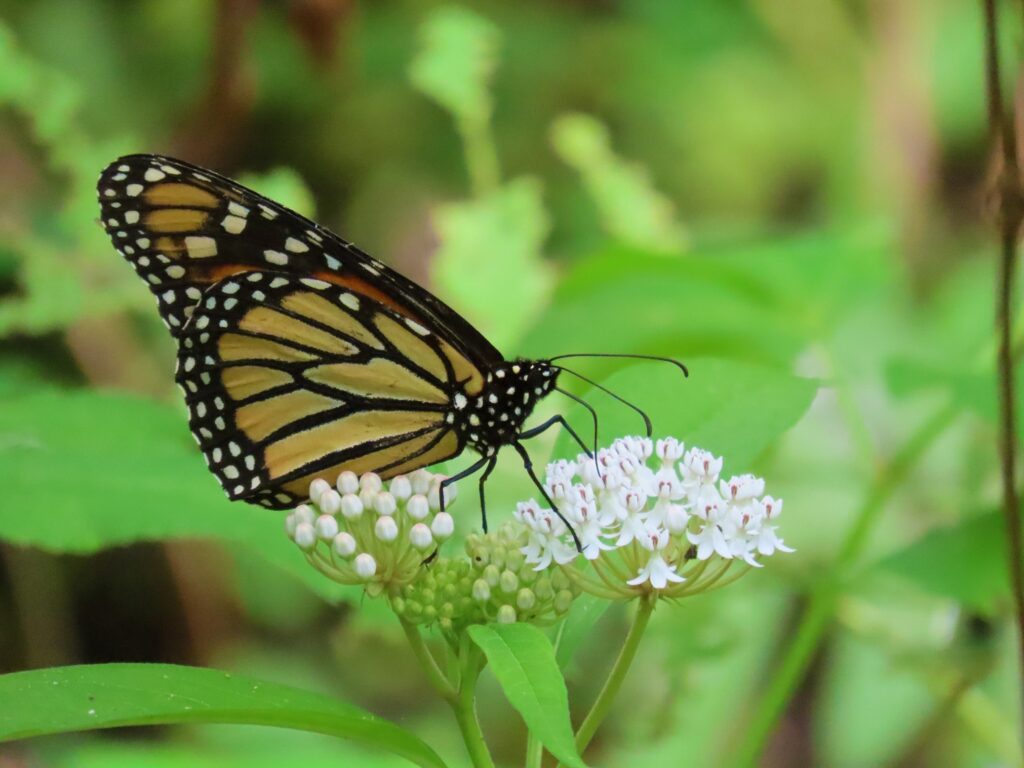
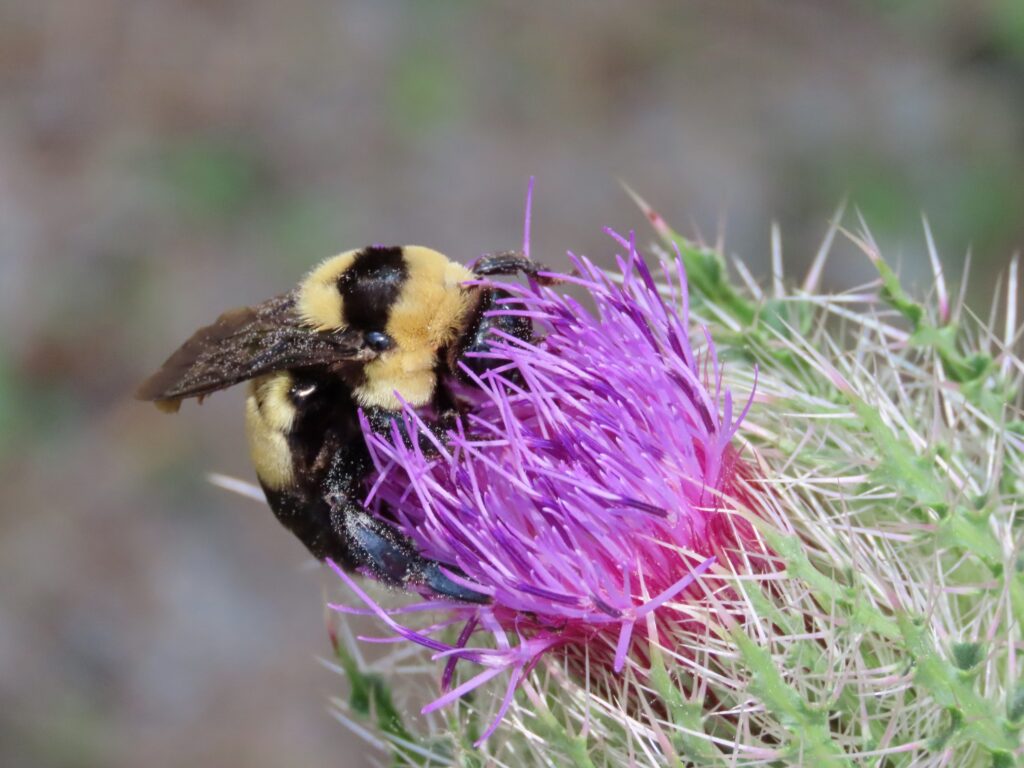

This year for Pollinator Week (6/17 – 6/23) we’re doing a 7-part series about native pollinators on Edisto Island!
Many of our flowering plants rely on pollinators to spread their pollen far and wide. But why do plants need pollinators? Insect pollination encourages cross-pollination between two unrelated plants, increasing a population’s genetic diversity and resiliency to climatic shifts, disease outbreaks, and environmental changes. It also allows a plant avoid producing the massive amounts of pollen needed for wind pollination, making the process more efficient for the plant. This frees up resources the plant can allocate towards growth, or producing nectar.
Nectar is the currency that plants use to pay pollinators for their hard work. It’s a deep-rooted mutualistic relationship. Native plants rely on insects to keep their populations healthy and insects rely on the plants for food. In the end, both groups are better off. This makes pollinators a lynchpin in the long-term health of our native ecosystems, and many plants need cross-pollination to set seed at all. Pollinators are thus extremely important to human agriculture. Many fruit trees and vegetables need insect pollination to produce viable fruit. If insect populations drop, agricultural yields can plummet even though all other site conditions are ideal. This is why recent trends of insect and pollinator declines are disturbing and worrying to ecologists. European Honeybees have been declining due to a myriad of pressures, such as increased misuse of insecticides in residential settings, foreign diseases and parasites becoming more established, and new invasive species, like the bee-eating Yellow-legged and Japanese “Murder” Hornets. These rising threats are highly damaging for beekeepers and agriculture. In parallel, our native pollinators aren’t able to pick up the slack due to similar pressures, such as systemic misuse of insecticides in residential areas, over-reliance on insecticides in agricultural settings, invasive plants, and habitat loss. The Monarch Butterfly and both the Southern Plains and American Bumble Bees are even candidates for listing as endangered species. However, we can mitigate these losses locally if we all help provide our pollinators with pollinator habitat.
This year for Pollinator Week (6/17 – 6/23) we’re doing a 7-part series about native pollinators on Edisto Island!
First things first, what’s a pollinator? It’s simply an animal that moves pollen from one flowering plant to another. Most often this is a flying insect but birds, bats, and ants will also pollinate. We have 5 main groups of insects that serve as pollinators: Bees, Wasps, Flies, Beetles, and Butterflies.
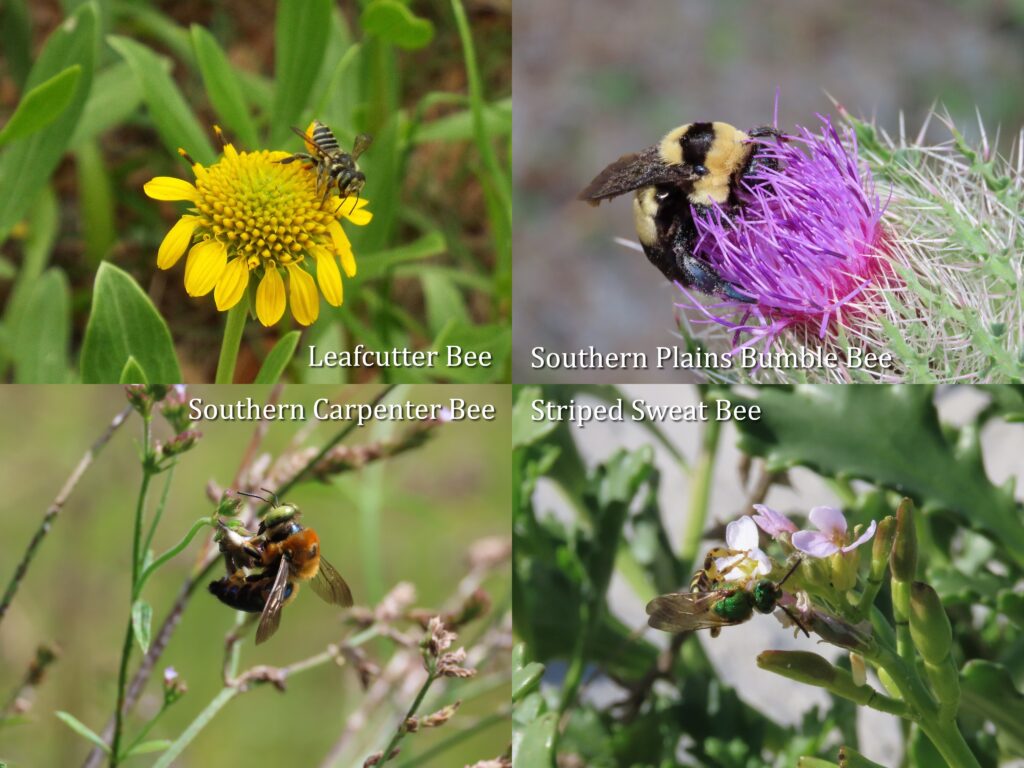
Bees are the powerhouses of the pollinator world. They do the lion’s share of pollination. Adults eat mainly nectar and feed their larvae pollen and nectar. Our native bees, especially Bumble Bees, do the bulk of the pollination in natural areas and small gardens. Honeybees, an exotic domesticated species, pollinate agricultural fields and orchards.
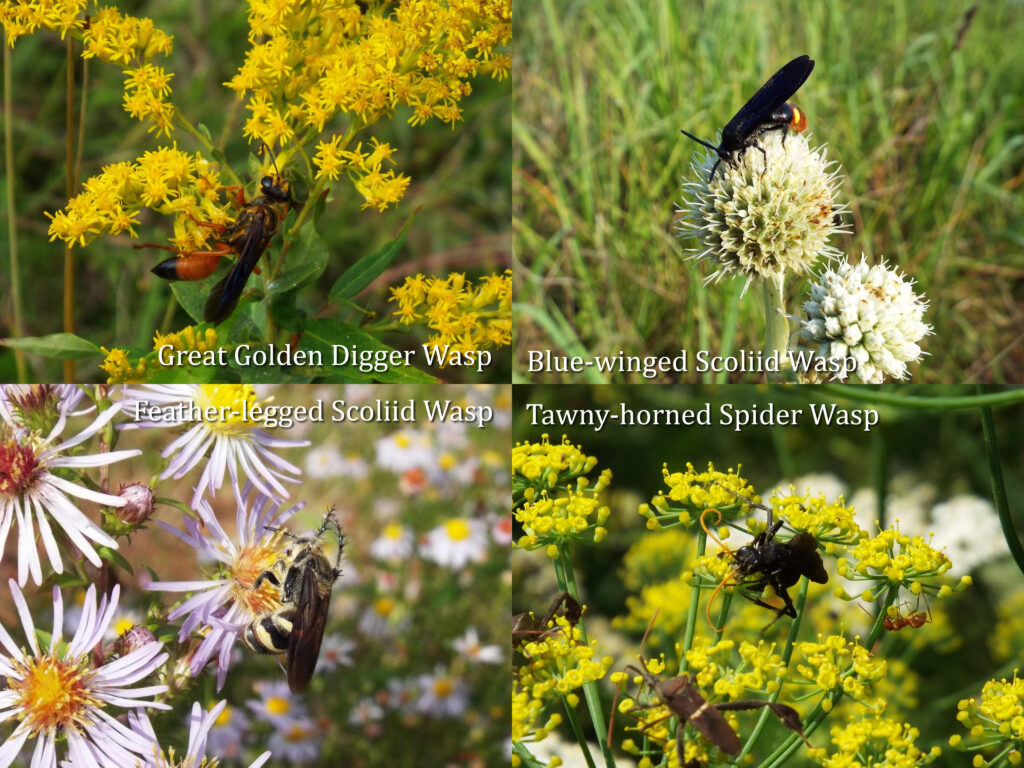
Wasps are anti-heroes among pollinators. Adult wasps eat nectar and do a lot of pollination in the process. They also hunt caterpillars, spiders, and other insects to feed their young. This helps control insect populations and stabilizes an ecosystem.
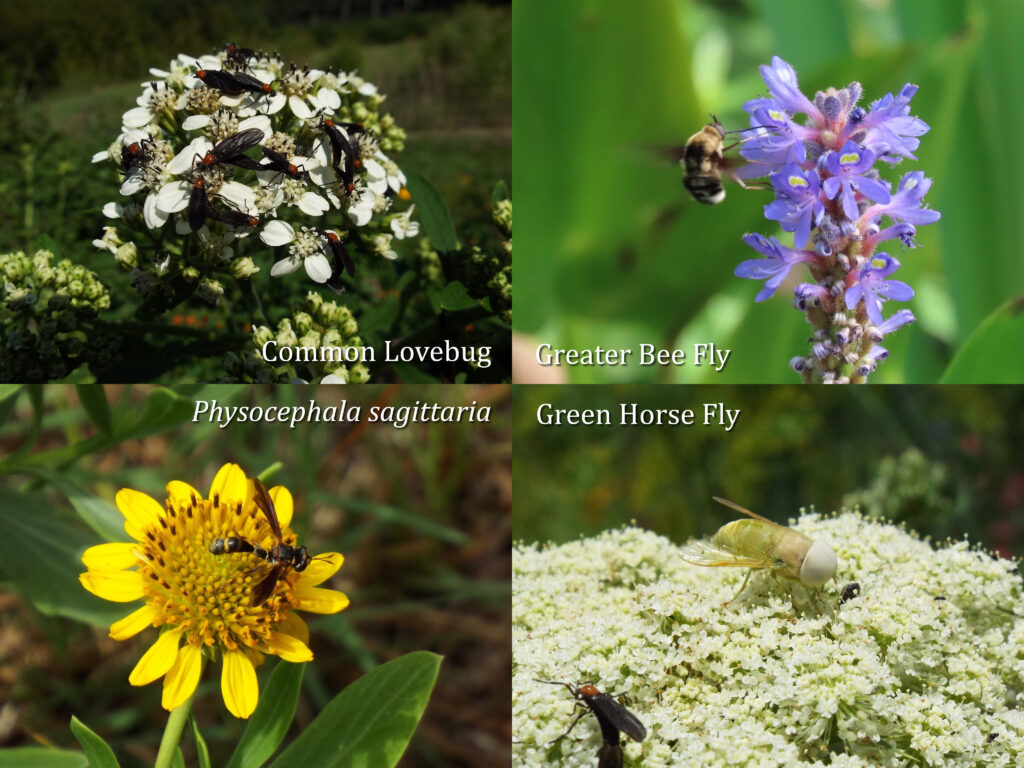
Flies are the unsung heroes of the pollinators. They do a ton of pollination on smaller flowers that are not often visited by other pollinators. There are also many plants with extremely specialized pollination tailored to just one species of fly. Another group, the Flower Flies, have carnivorous larvae that feed on pests that plague pollinator plants.
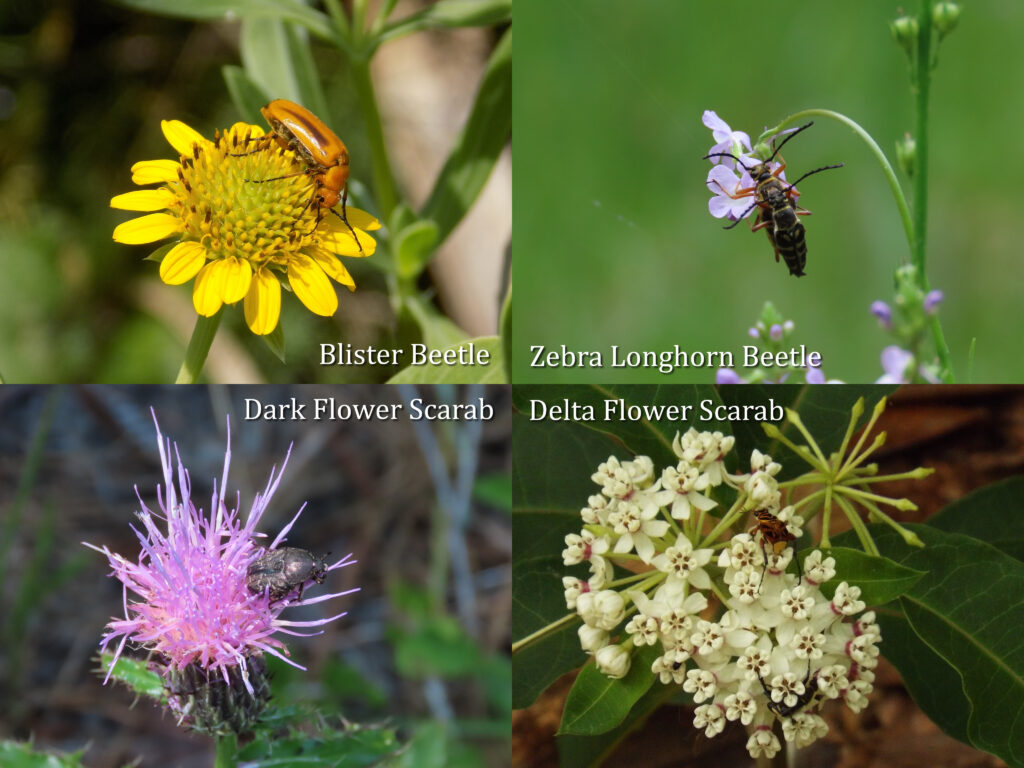
Beetles are our pollinator old guard. The original pioneers now stuck in their ways. Beetles are sedentary and uncoordinated, making them inefficient pollinators. However, some plants take advantage of these bumbling beetles to douse them with pollen and to make unwitting pollinators. Butterflies are the celebrities of our pollinators. They’re good looking and they soak up a lot of energy, resources, and attention, but don’t do all that much.
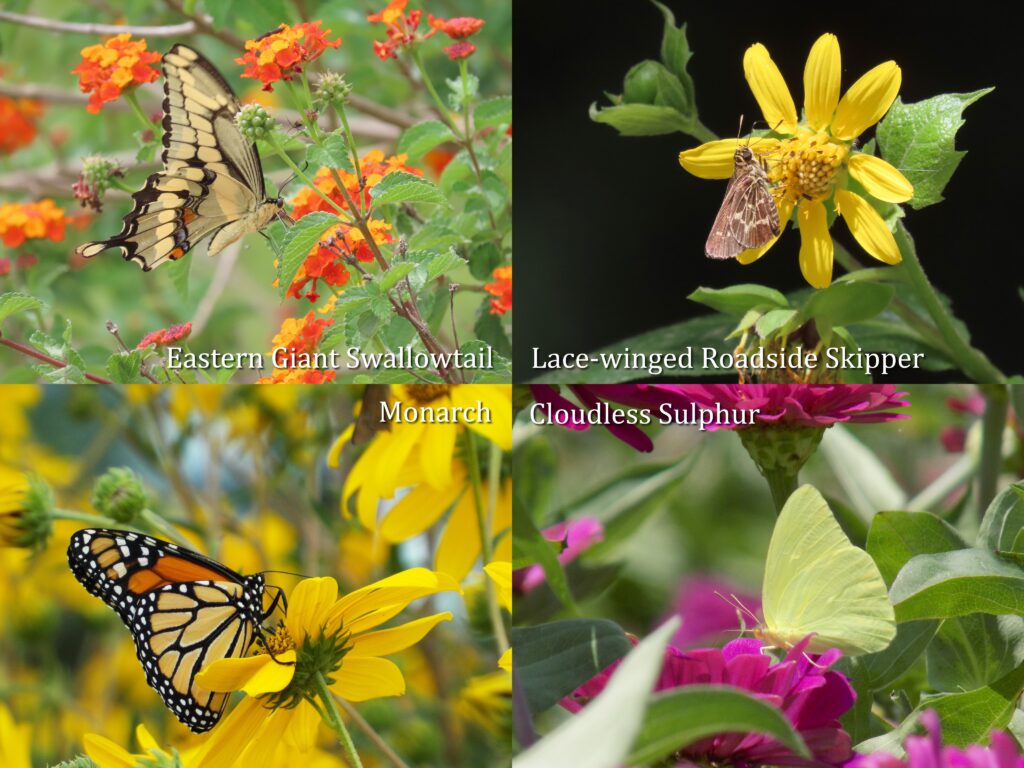
Butterflies are very well adapted to drink nectar and not get pollen on them. Yet, certain plants make use of butterflies as preferred pollinators. Further, butterfly larvae feed on plants, this helps control plant populations and keeps any one plant species from dominating an ecosystem.